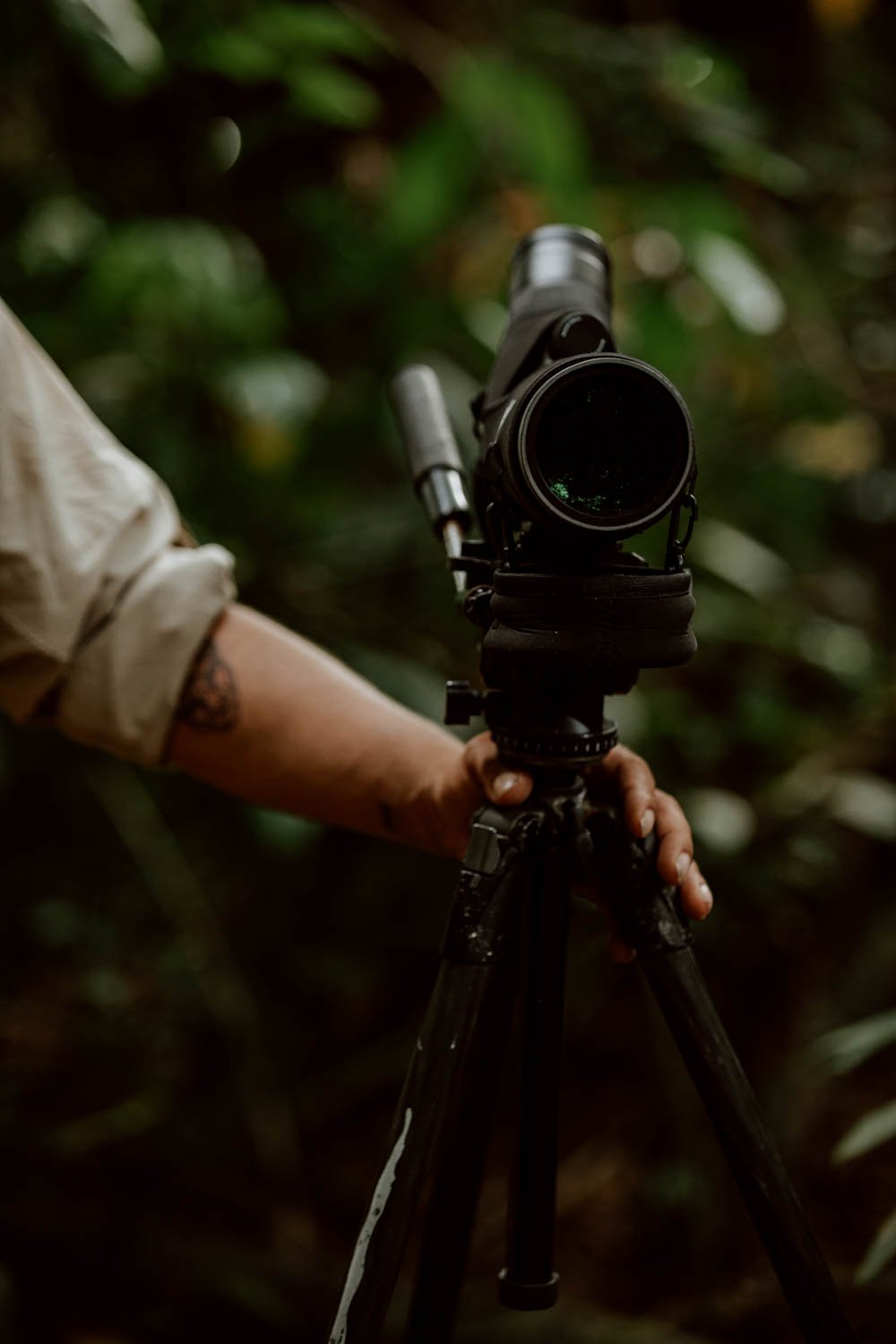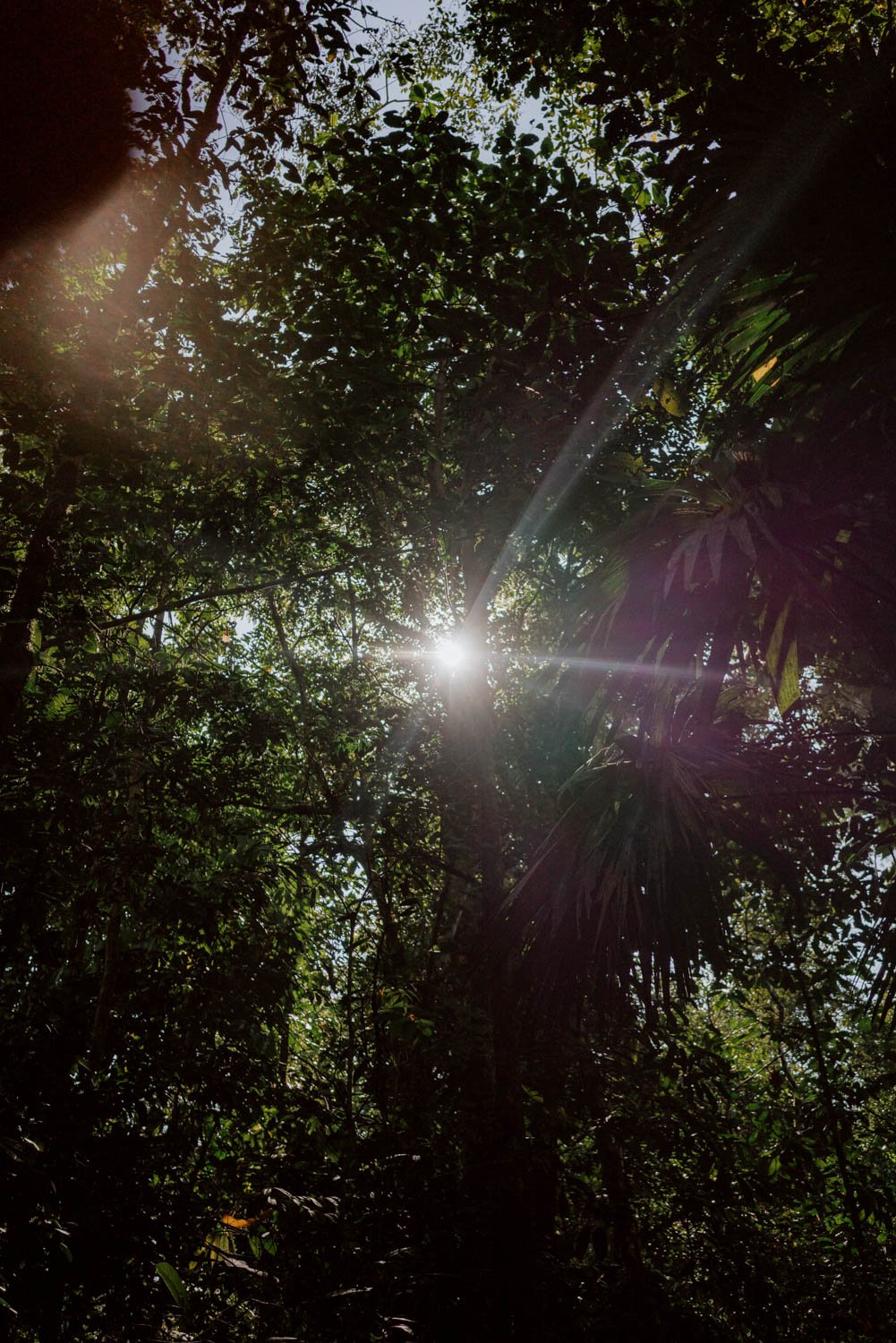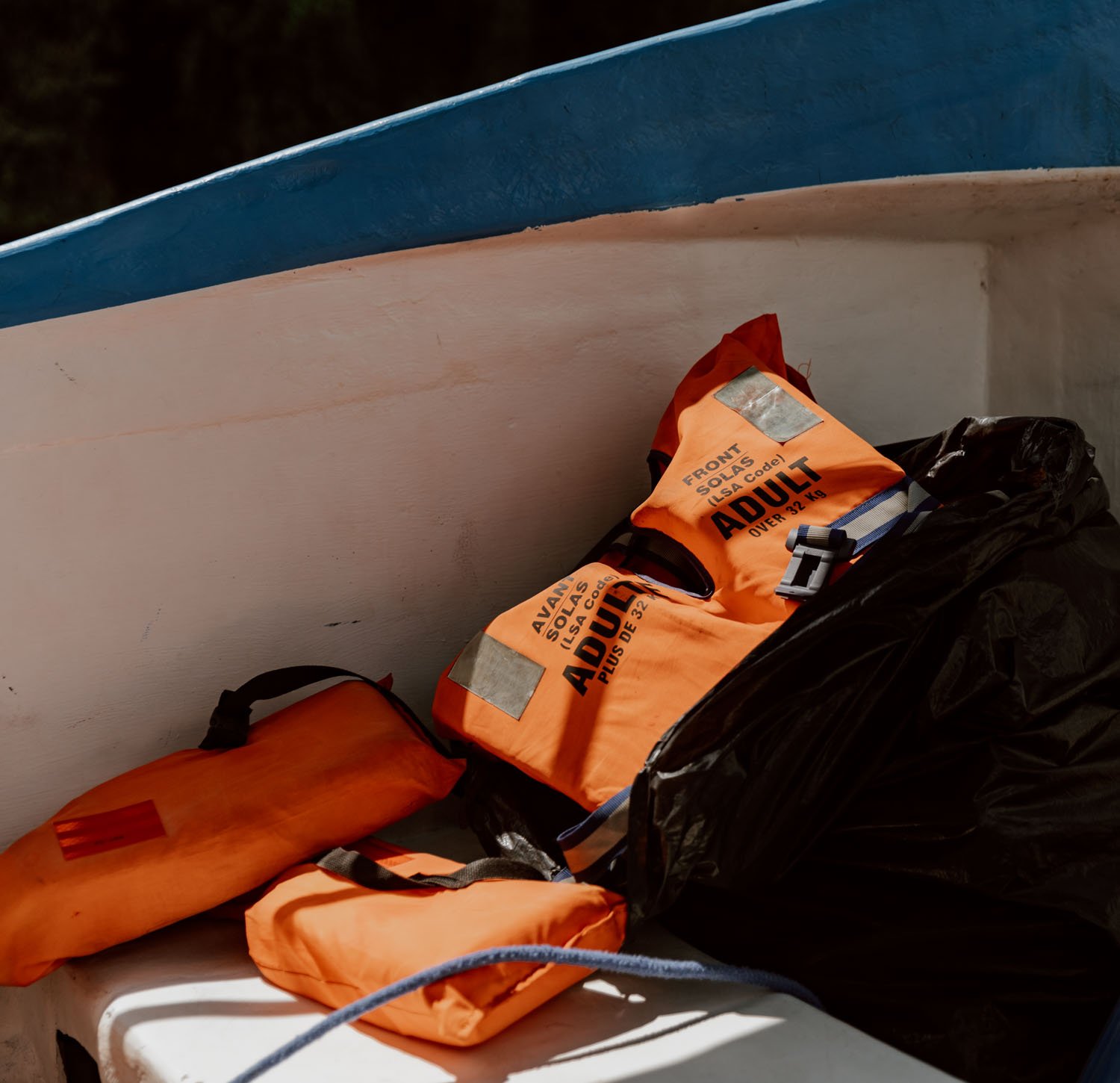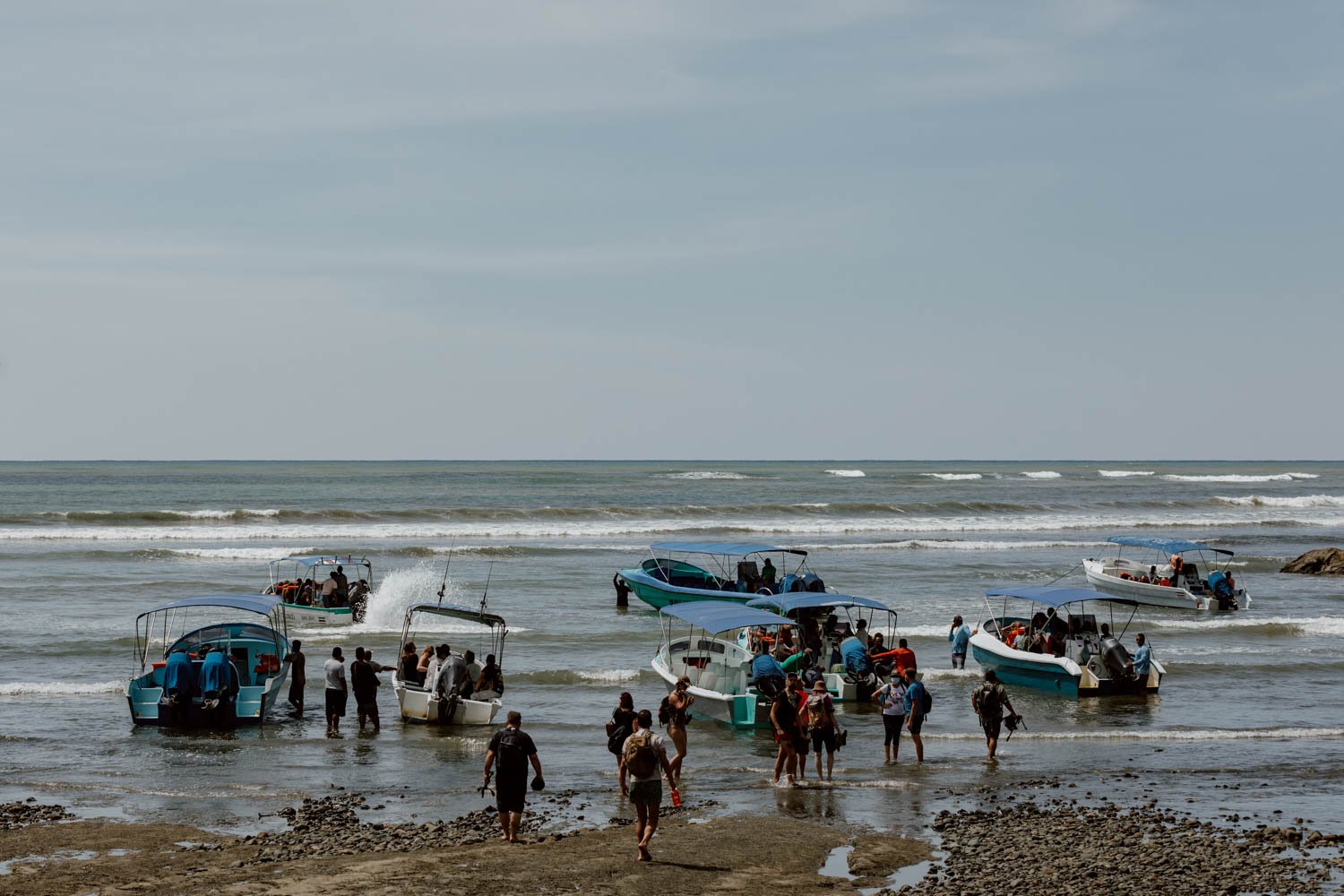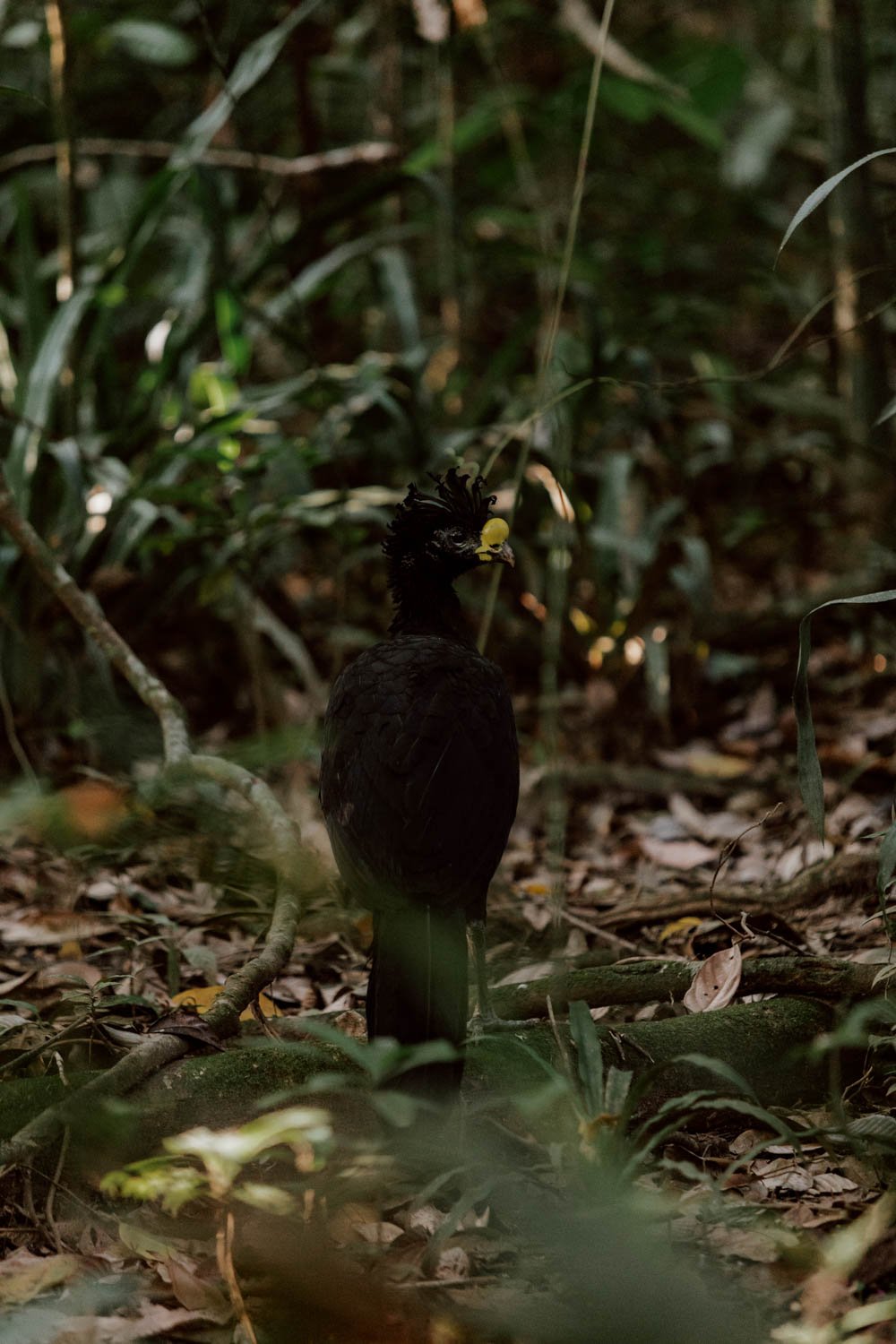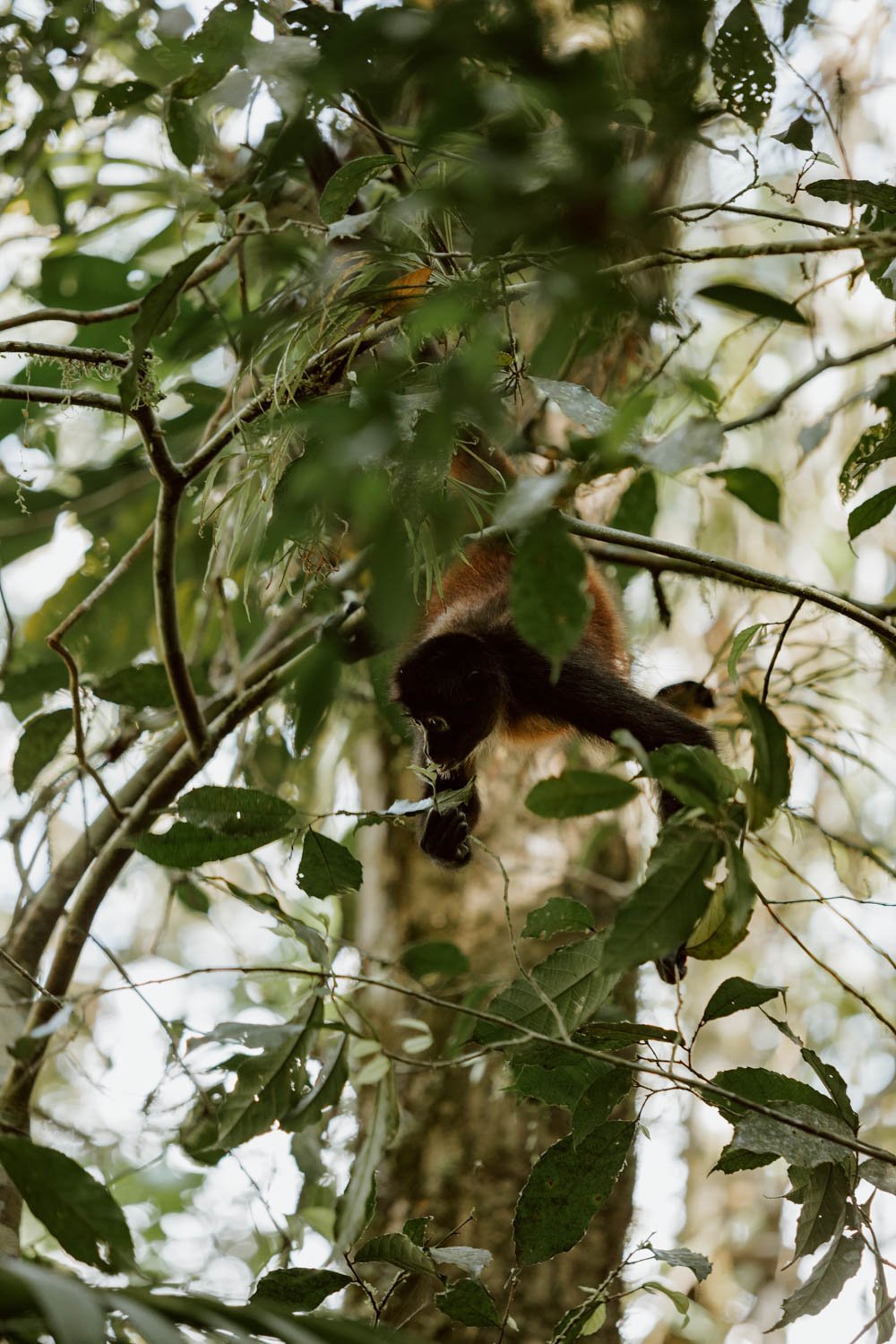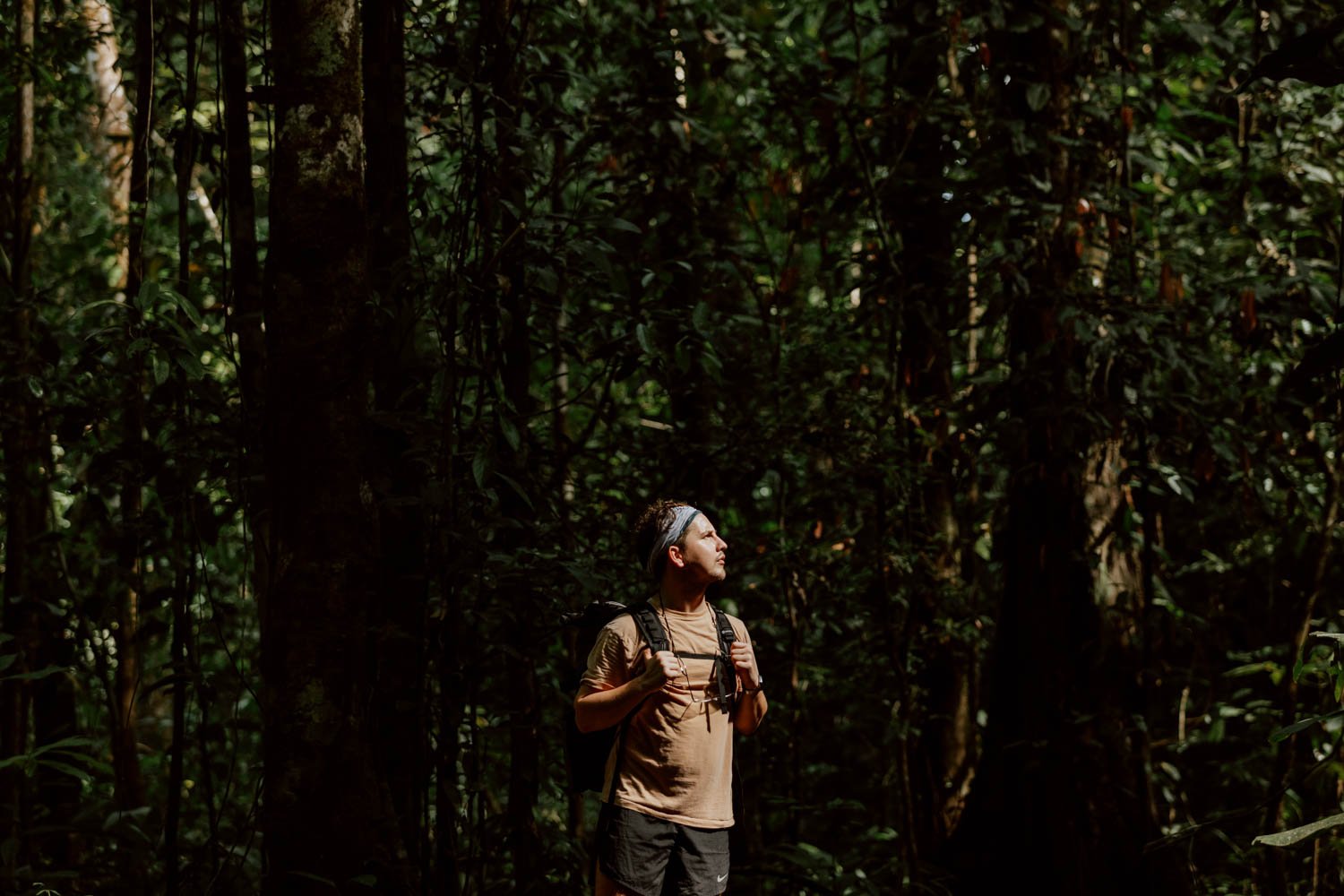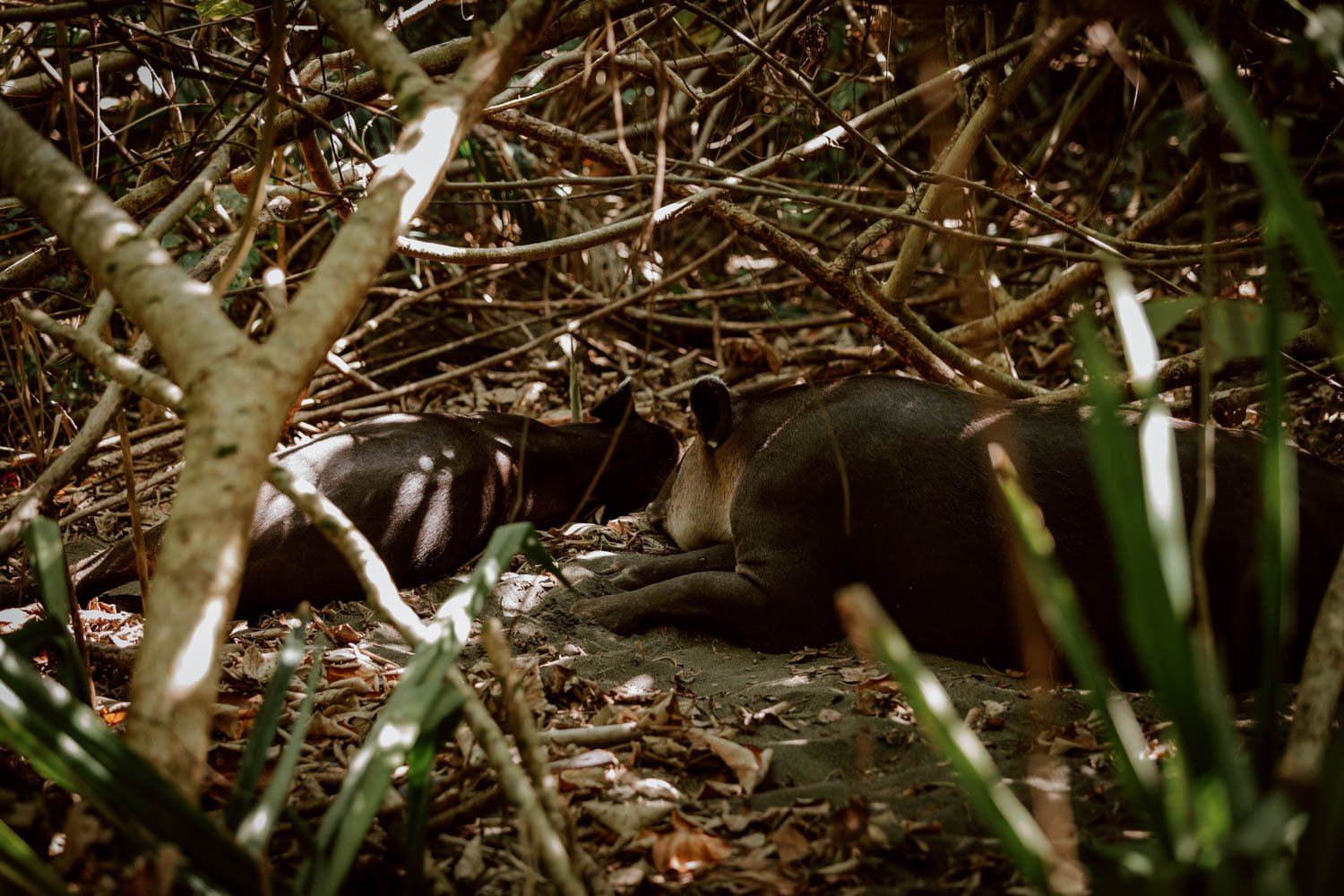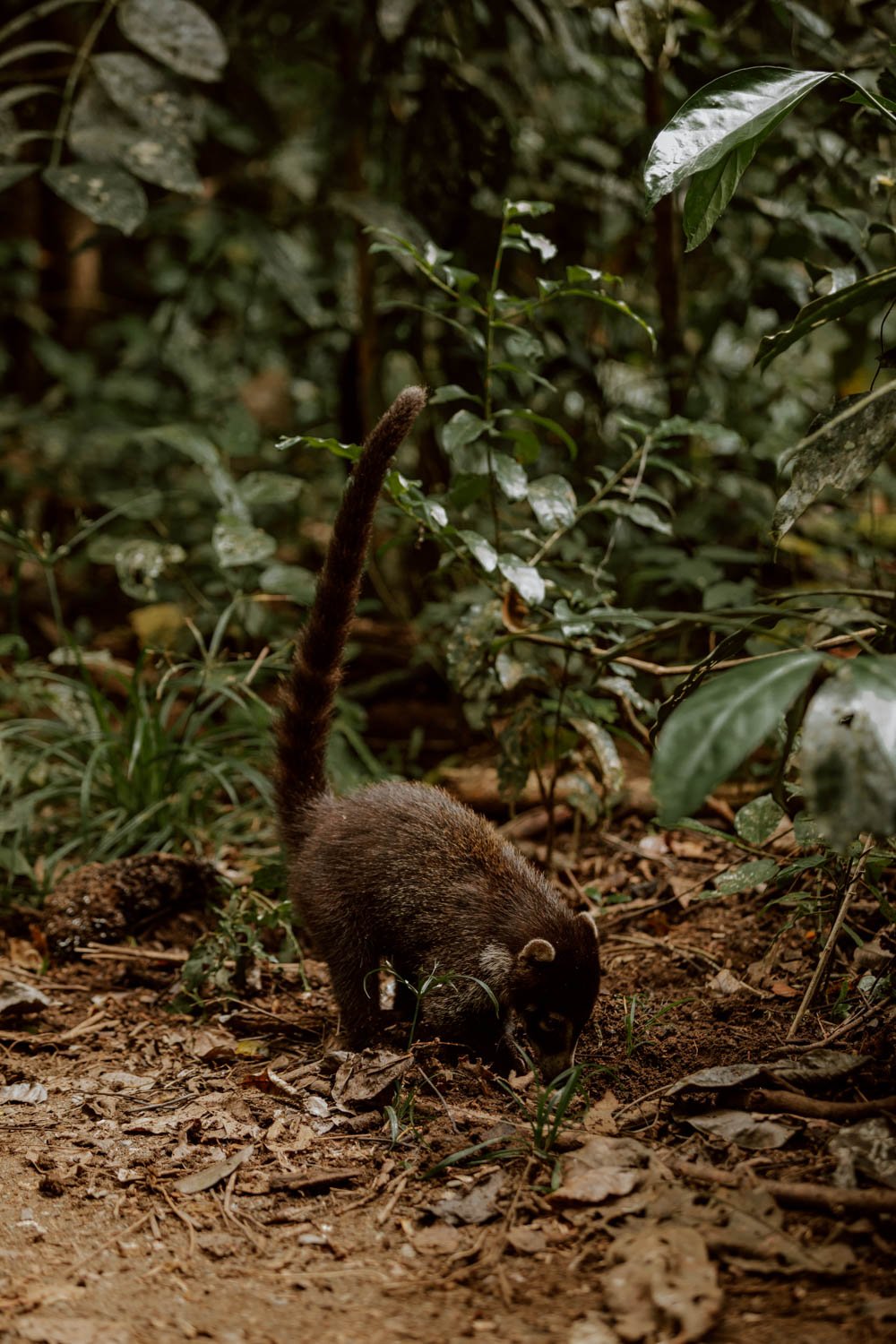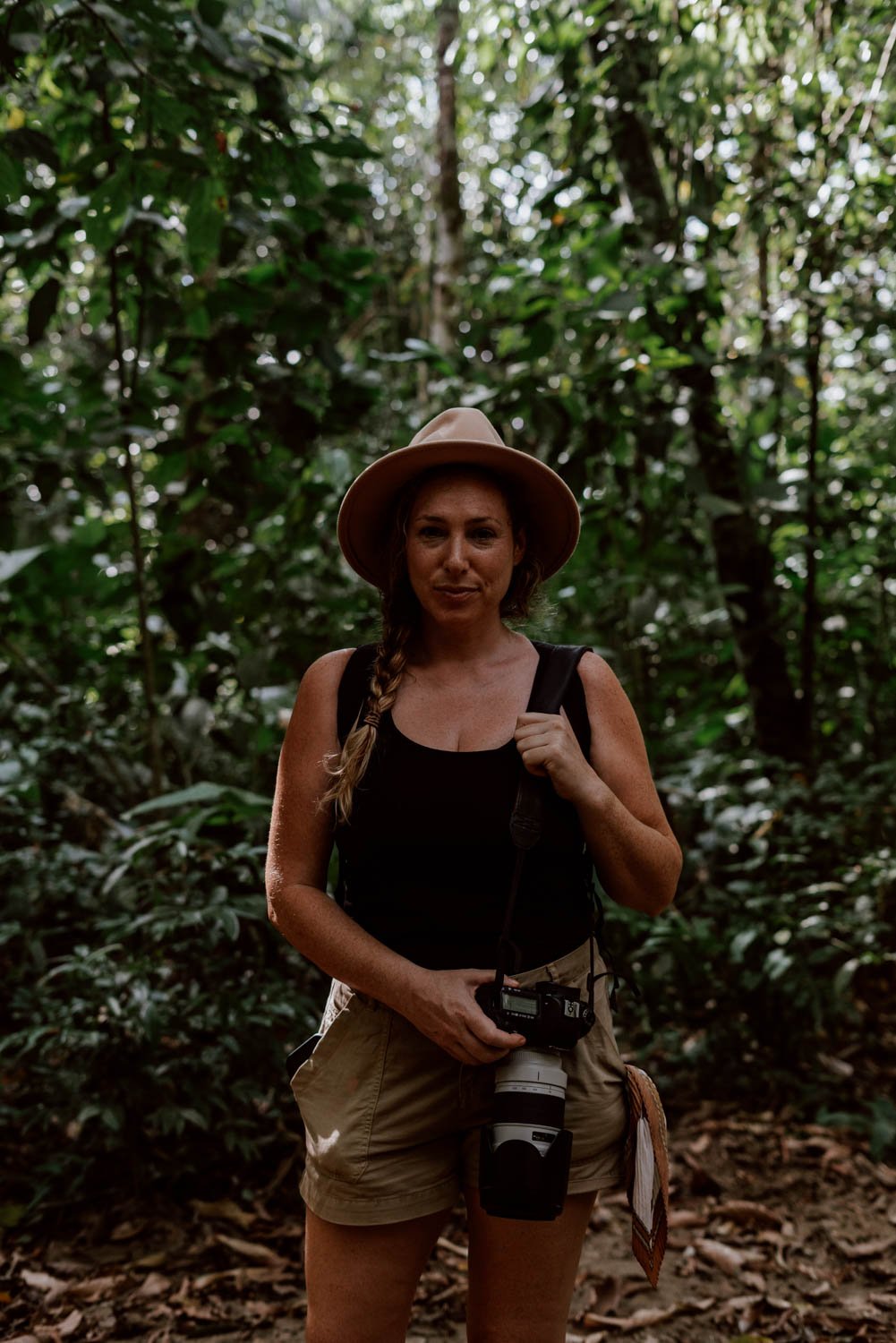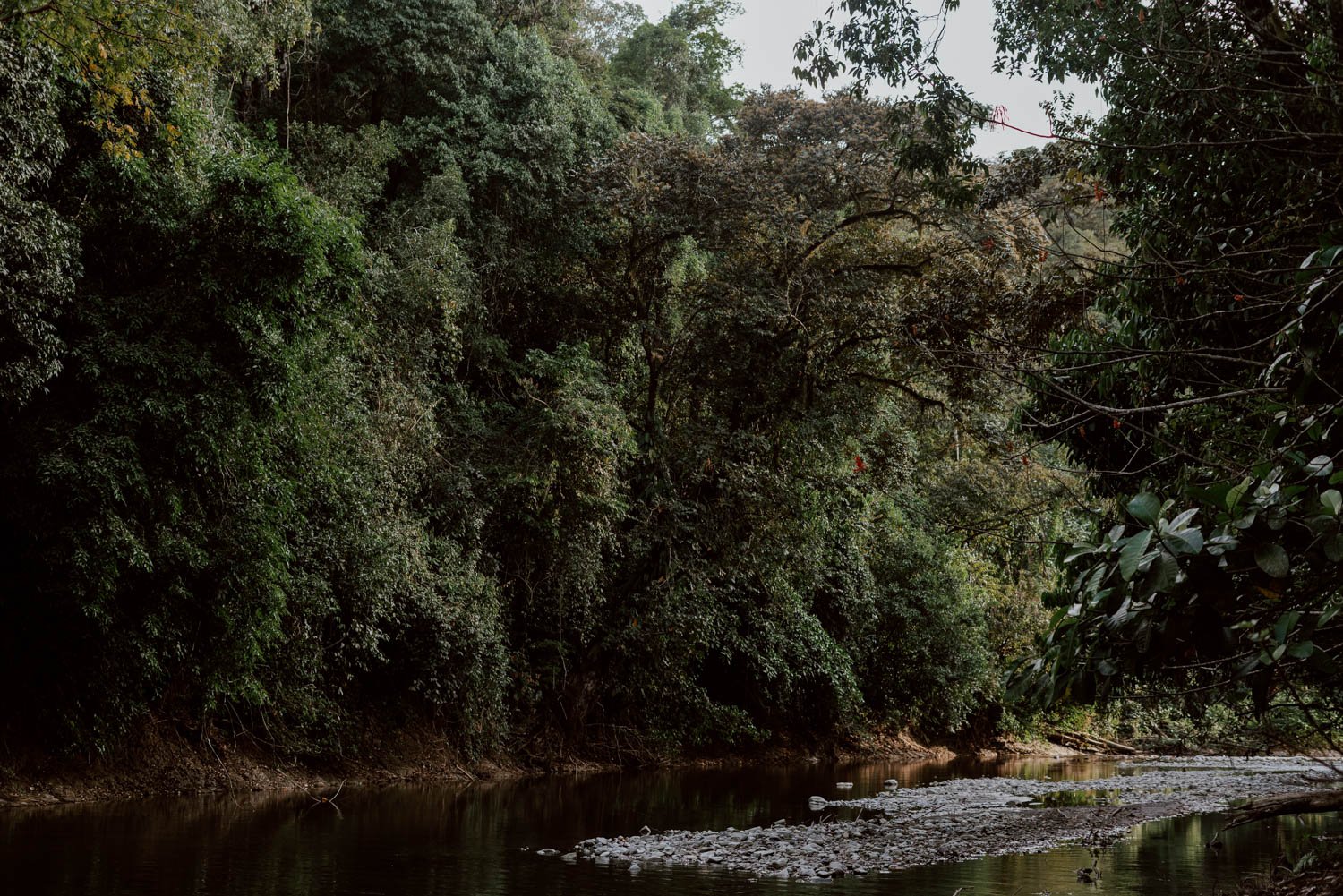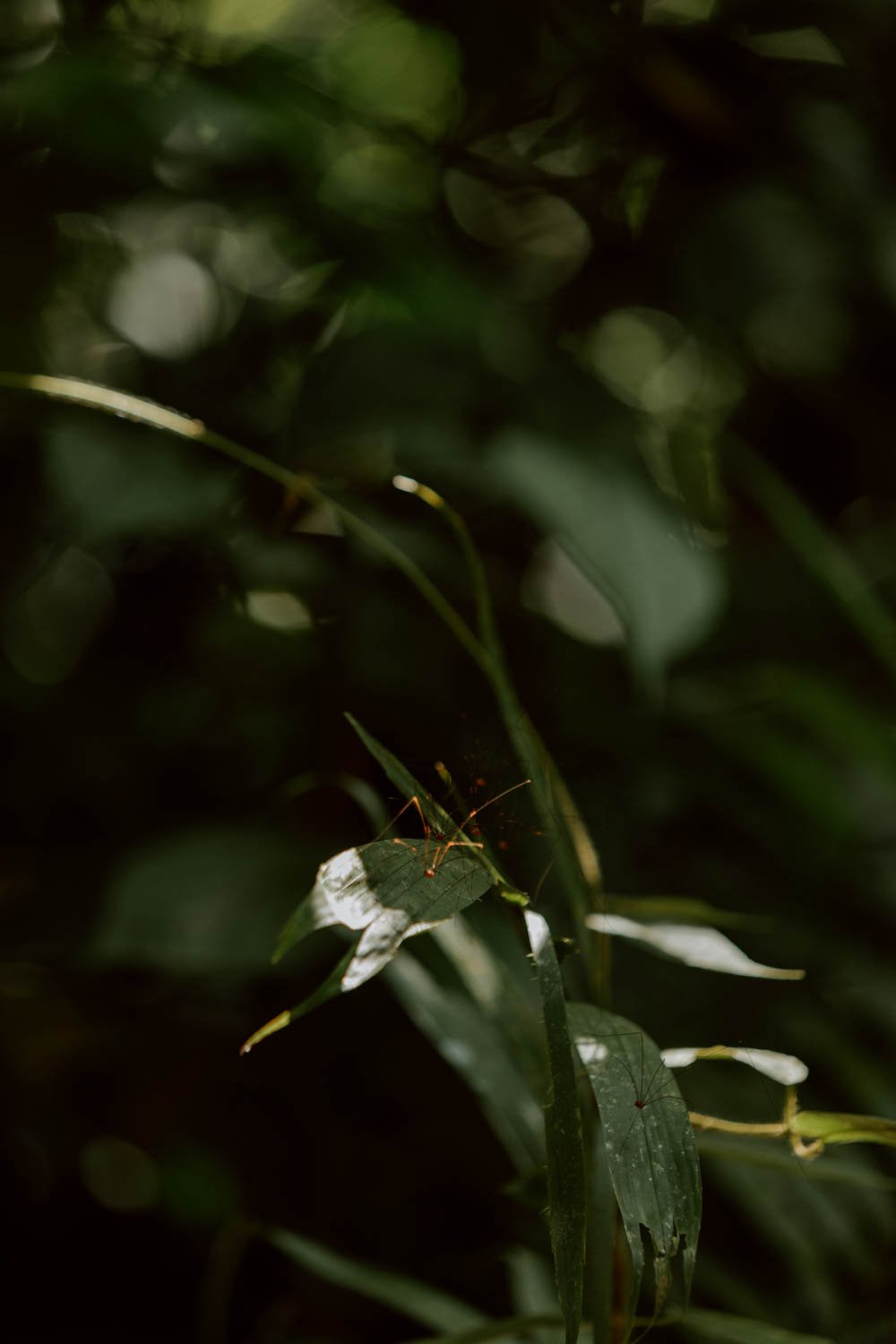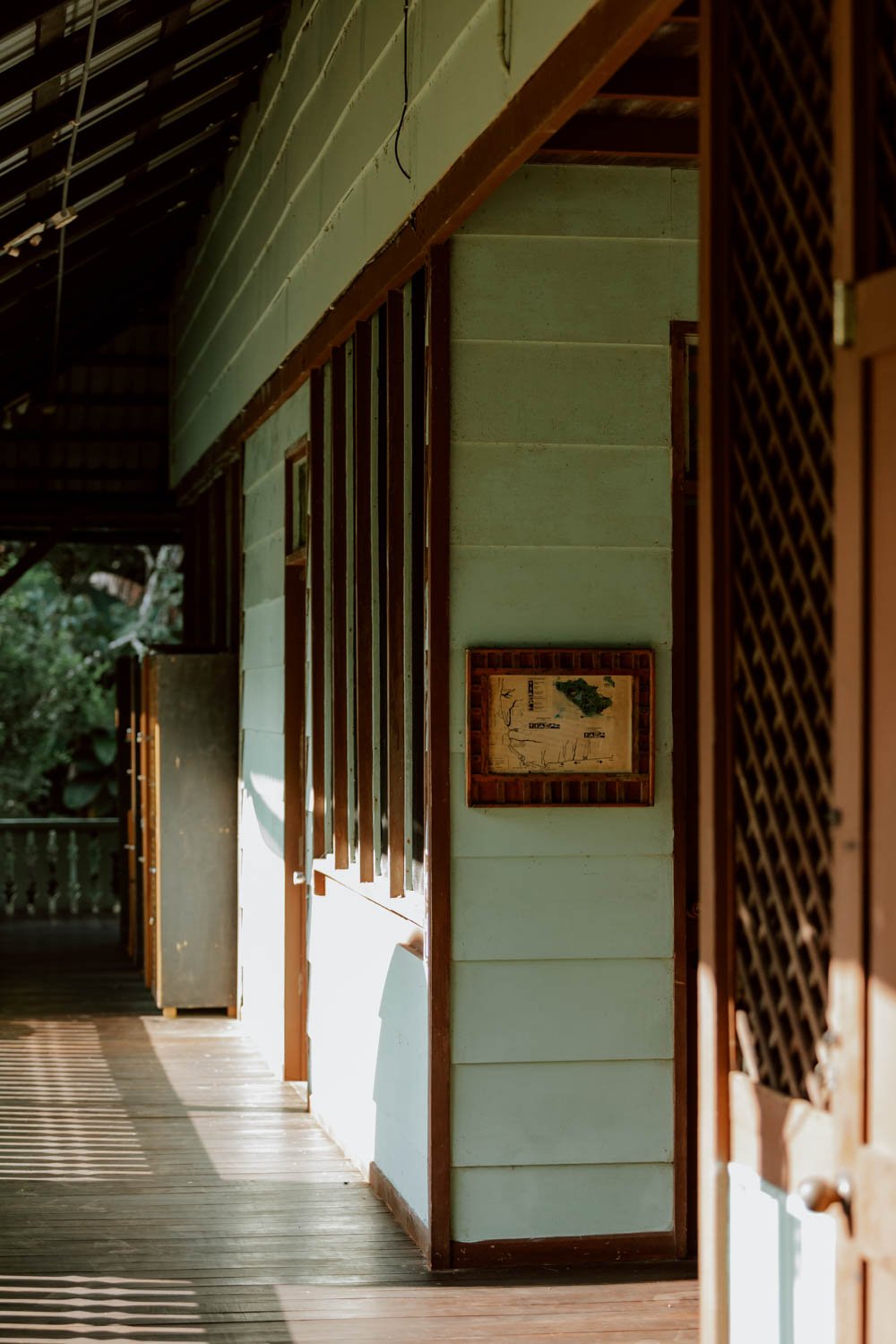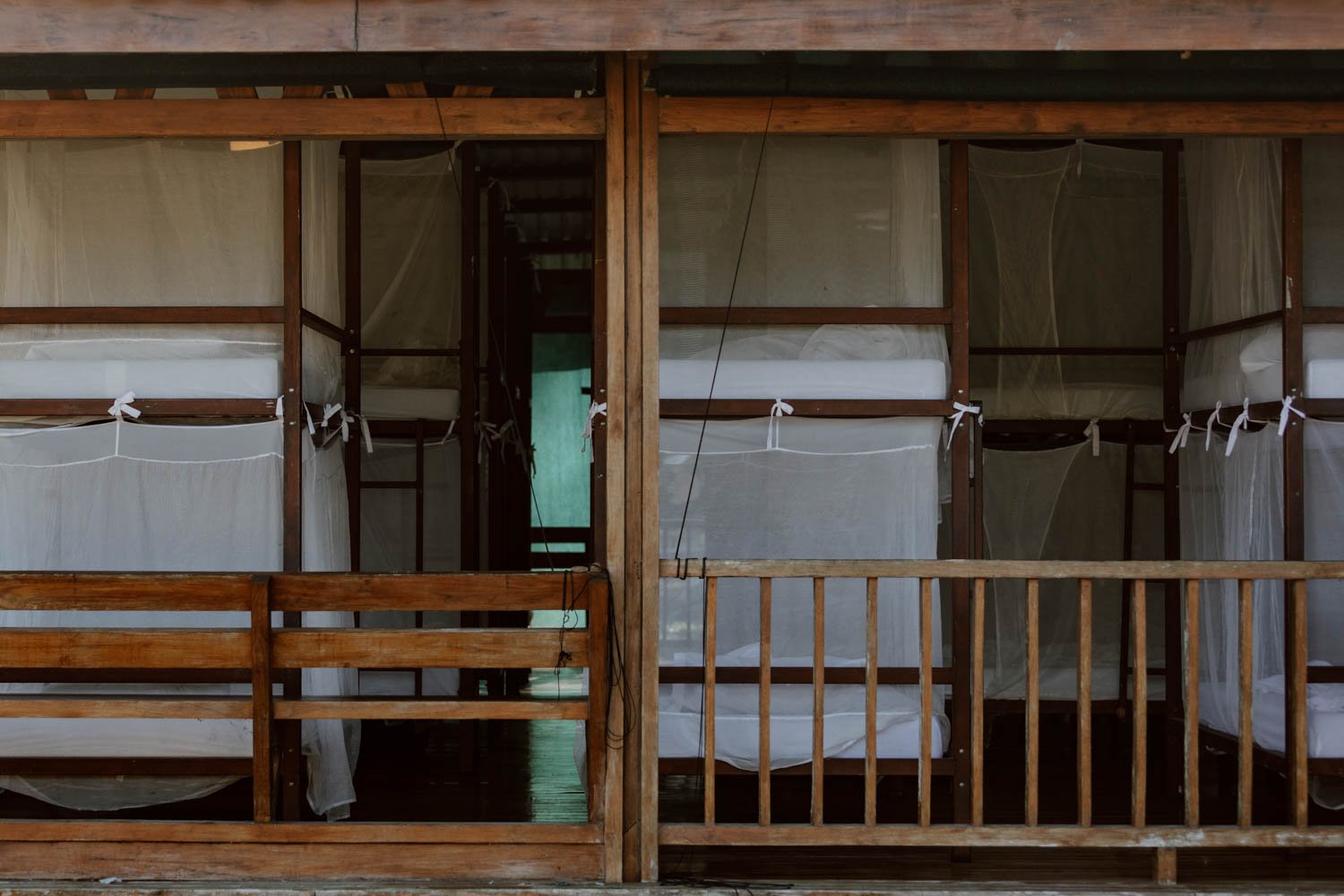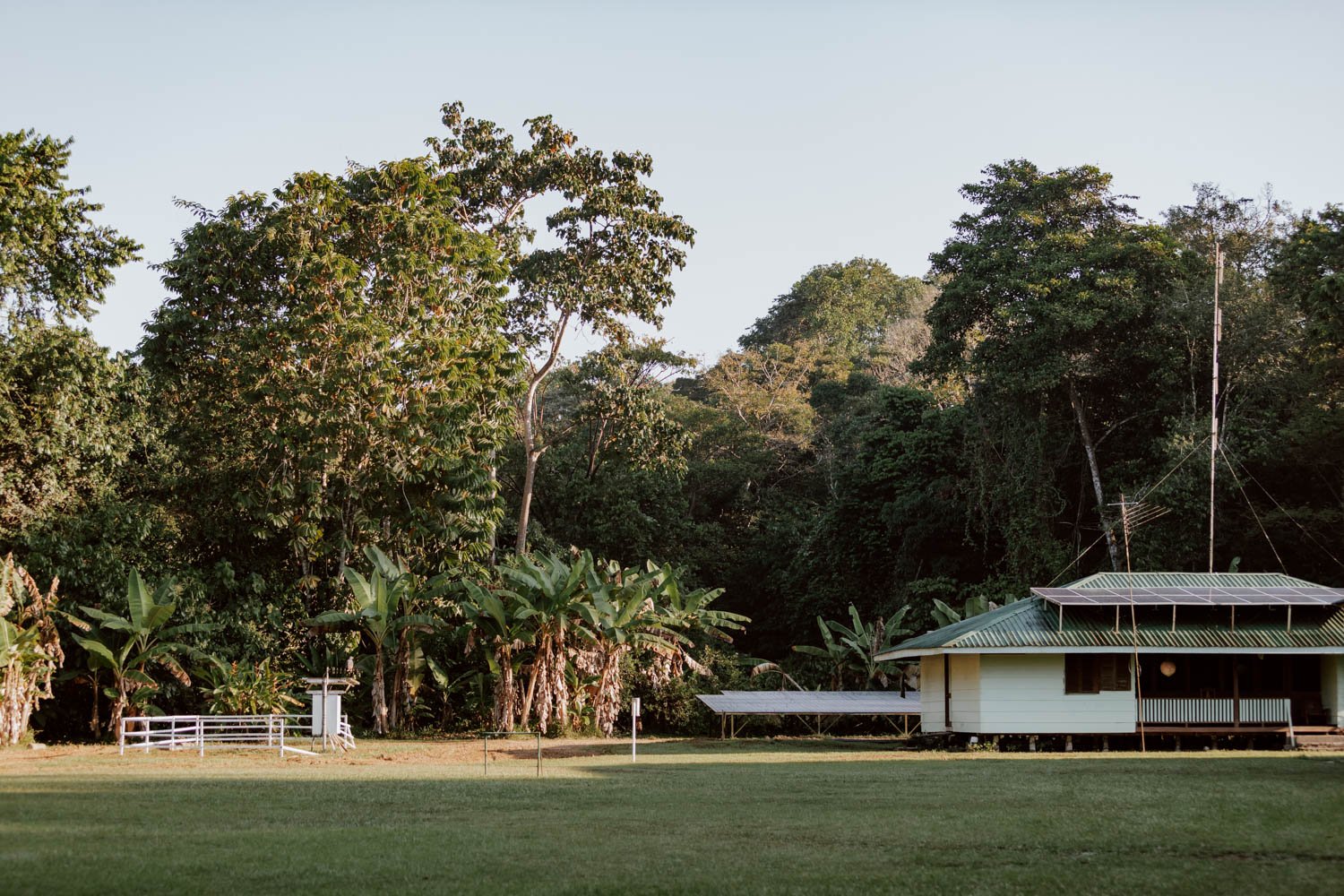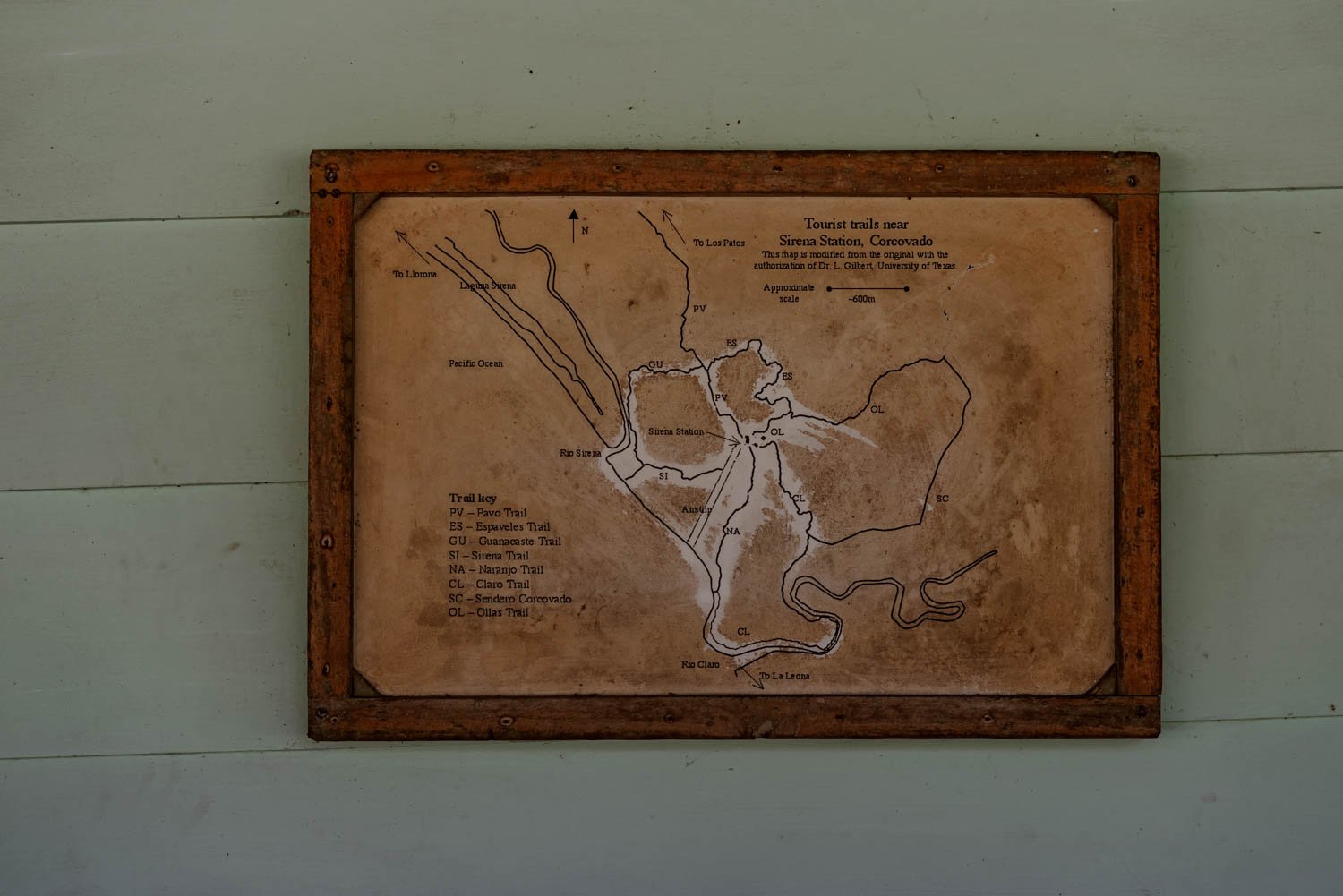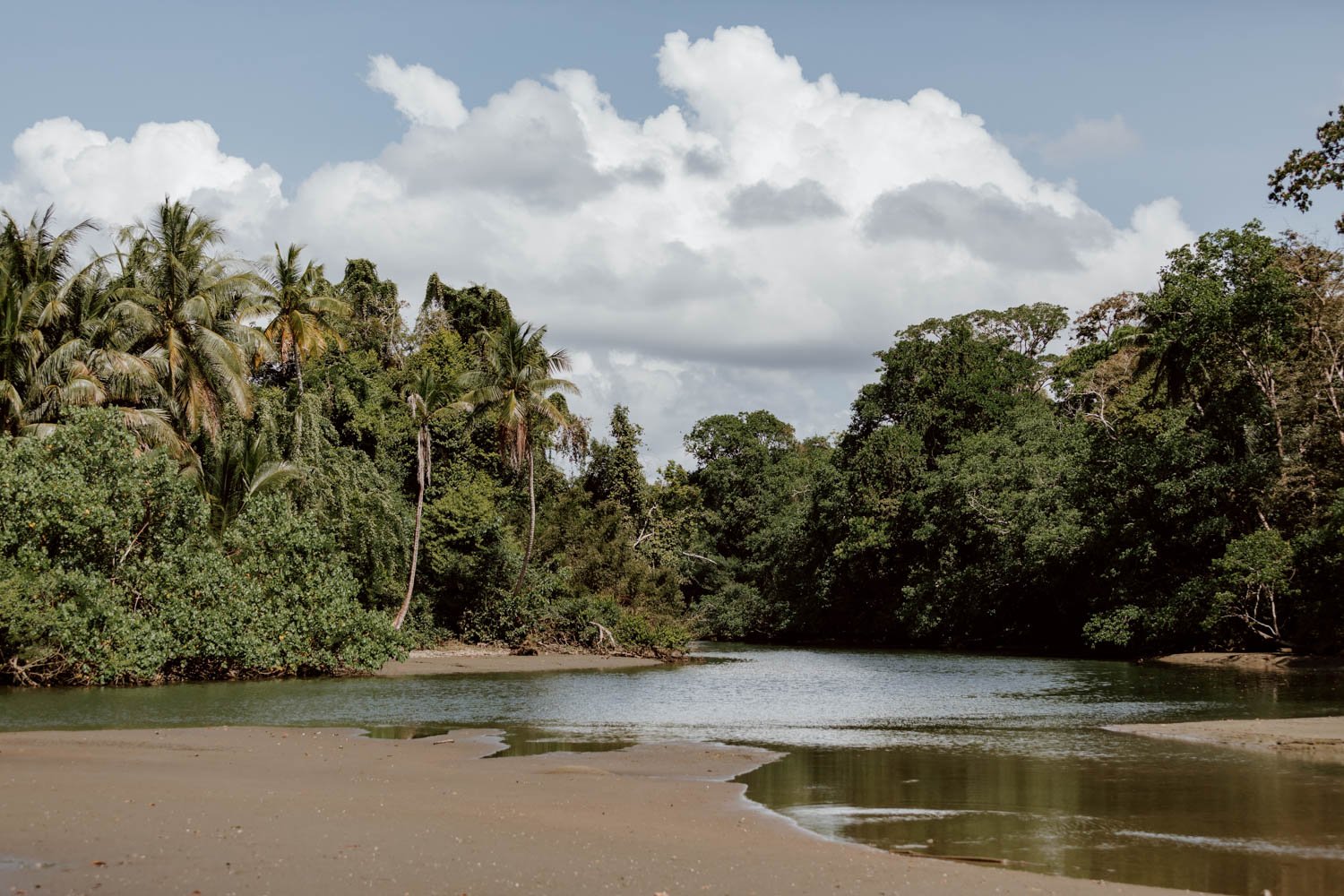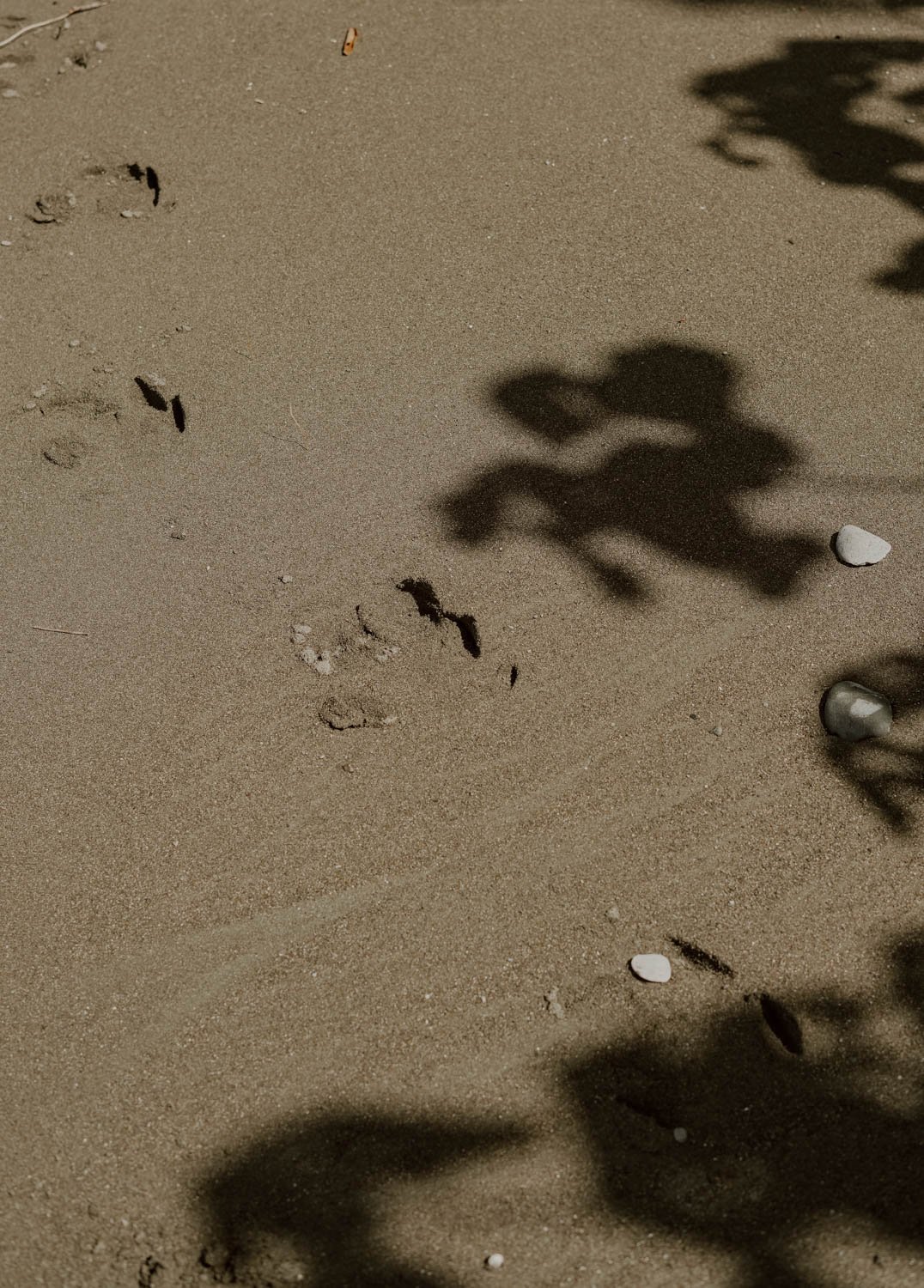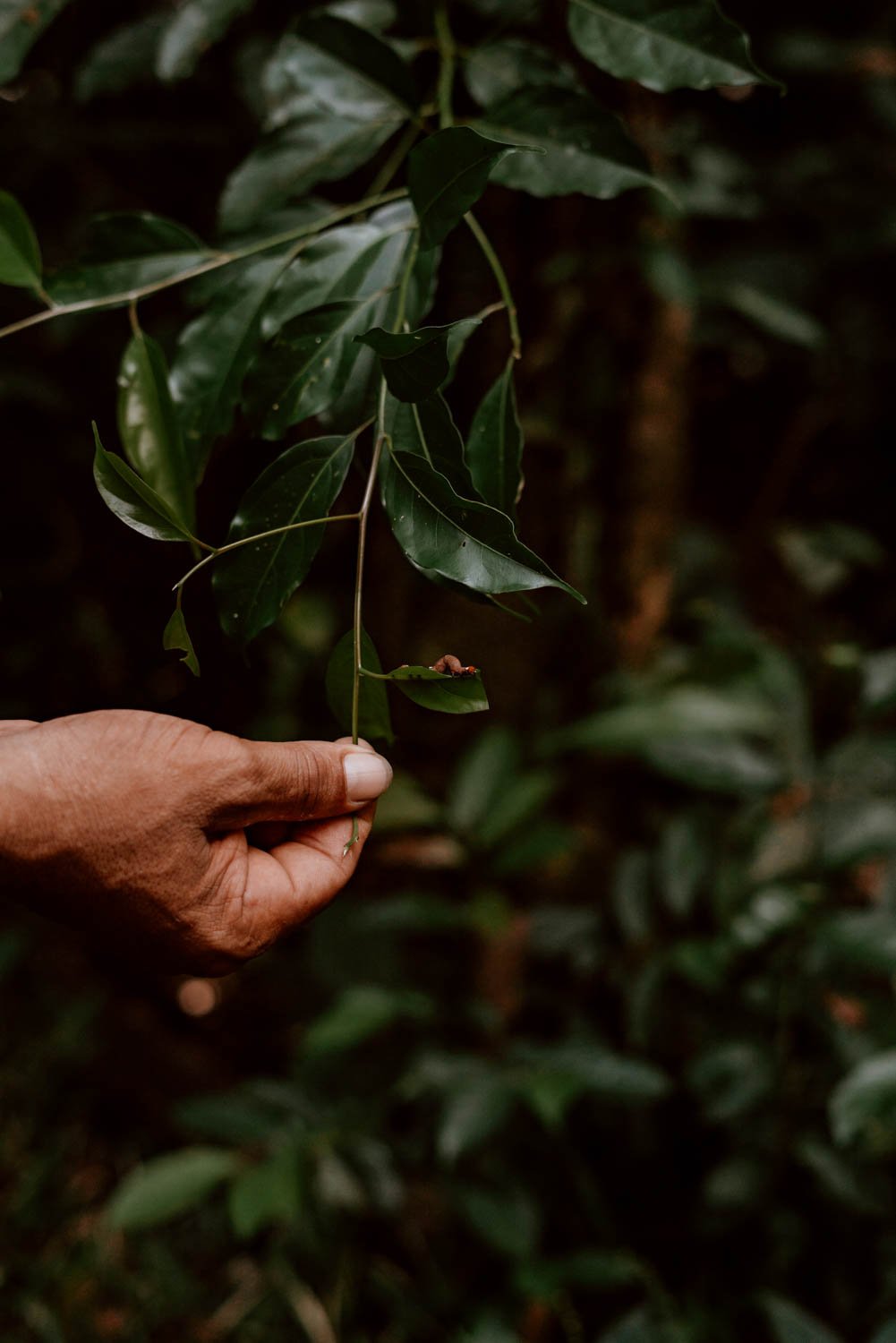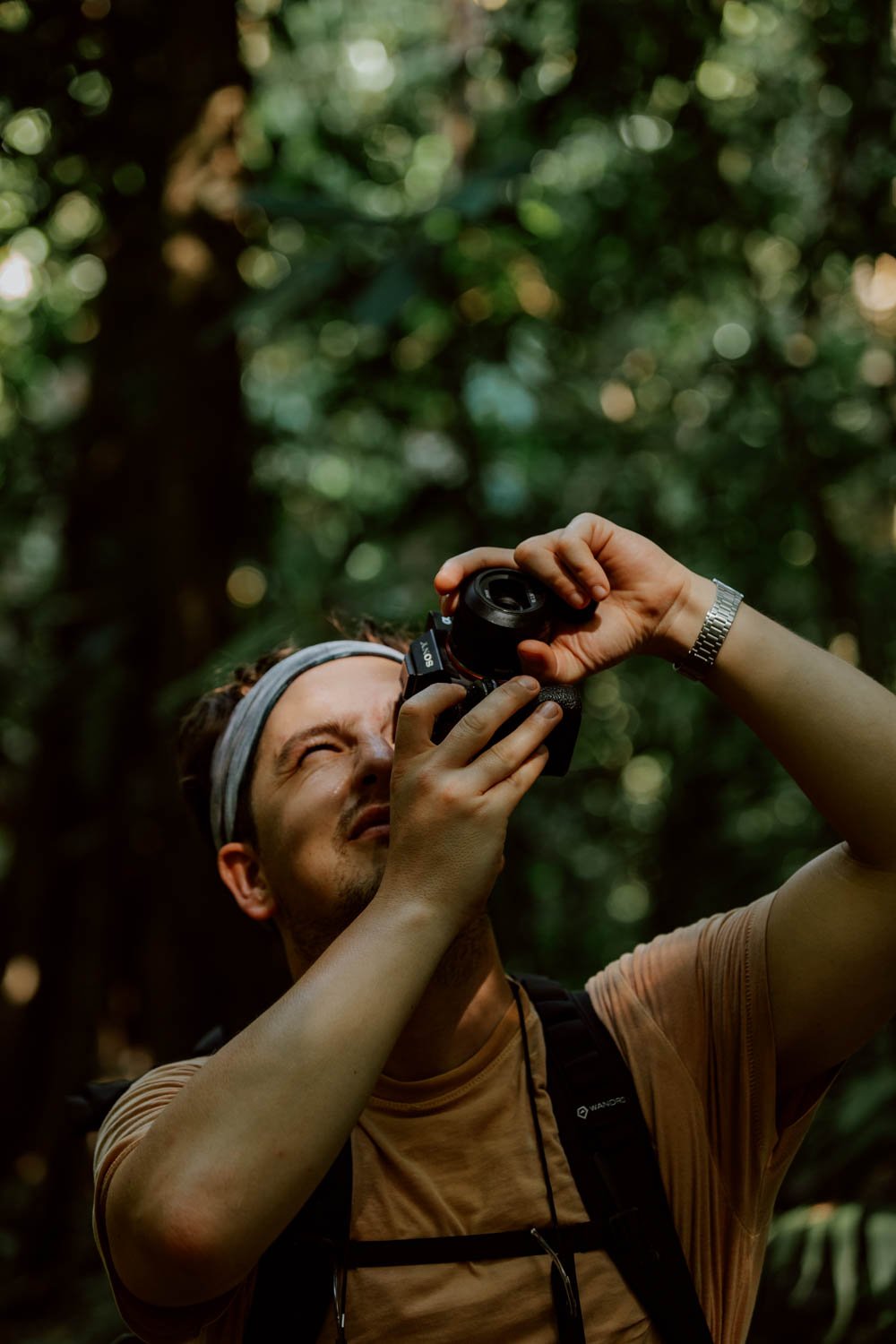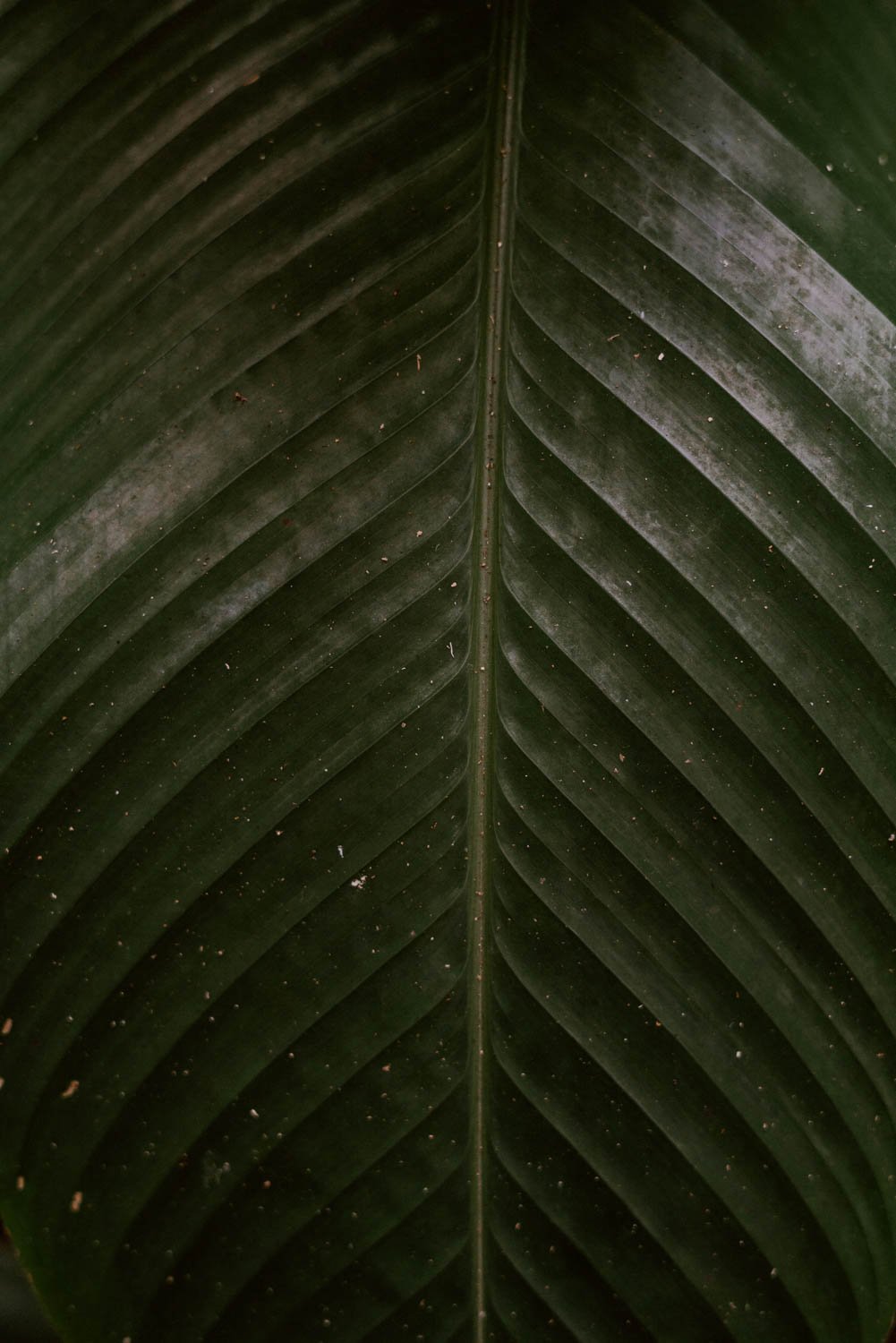Planning to visit Corcovado National Park in Costa Rica?
As it doesn’t operate like any other national park in the country, there are quite a few things you need to know before you go - our guide’s got you sorted!
Updated January 2024
The howler monkeys awake with a roar at quarter to five.
Somehow, it manages to sound both prehistoric and hypermodern: part-dinosaur call, part fighter jet flyover, their guttural shriek crosses millennia and echoes for miles.
This morning, it’s simply our alarm clock.
We are one of only eighty or so other human souls starting the day in the middle of Corcovado National Park, the largest national park in Costa Rica and the place which National Geographic (and now everyone else) describes as “the most biologically intense place on earth”.
Covered by thin white sheets and shrouded in blood-spattered mosquito nets, the two-legged residents begin to make their own early-morning noises: yawns, beeps, cracks and snaps as they stomp or shuffle across the hardwood floor toward the shared bathrooms.
Awaiting us, with freshly-inked puma tattoo on his left forearm, crazy curly hair, and an English accent which dips into a Caribbean lilt on the b’s, is Donny. Our tour guide for two days, he has 40/40 vision and a knack to spot even the most coy animal in the trees; he also has an uncanny ability to do a convincing howler monkey roar.
To unsuspecting, bleary eyed travellers waiting for the toilet at 5am, when the jungle is set in twilight and there’s already a sense of paranoia at what you may encounter this deep in the wild, you could be forgiven for for thinking it’s the real thing when he creeps up behind you…
Taking up a third of the remote and relatively hard to reach Osa Peninsula in southwest Costa Rica, the Corcovado National Park is a place where those travellers in search of untamed nature and adventure should make a point of visiting.
A place where being human makes you a minority species.
After our own overnight experience there, we’ve shared all the essentials to help you decide, plan, and prepare for your own visit to Corcovado. From advice on how to get there from elsewhere and the best base to choose, to insights on the various ways to visit and experience the park, the costs and complications of the booking system and daily visitor cap, recommend tours, and an honest appraisal on whether you really should commit a large chunk of your hard-earned travel budget to the overnight stay, we’ve got you sorted.
This is 23 Things To Know Before You Visit Corcovado National Park.
Corcovado | The Essentials
What / Costa Rica’s largest & most distinctive national park
Access / Via Drake Bay, Puerto Jiménez, or Carate
How / Tour guide + permit is mandatory, and you cannot visit independently. Visitor numbers are also capped meaning advance planning + booking is necessary
Day / Possible to do full-day tour - this one is super popular
Overnight / We recommend spending the night in the either at Sirena Station or San Pedrillo Station.
Cost / Prices vary but this is an expensive experience.
Alternative / Stay at an incredible jungle lodge on the edge of Corcovado like The Jaguars Jungle Rainforest Lodge
HOW TO VISIT CORCOVADO NATIONAL PARK
What Makes Corcovado Special?
Simply, it’s the sheer depth and diversity of flora and fauna that makes it so remarkable: 2.5% of the planet’s biodiversity is present here in only 0.001% of its surface area.
Covering a third of the Osa Peninsula, its thirteen ecosystems are home to 500 species of trees, the largest primary forest on the Pacific coastline of the Americas, some 10,000 types of insect, 375 species of bird, 160 reptiles and amphibian species, and 150+ types of mammal. There’s jaguars, pumas, and ocelots, the Baird’s tapir (we saw a mother and cub), all six types of Costa Rican monkey, sloths, ant-eaters, snakes, and the waters are home to bull sharks, crocs, caimans, turtles. whales and dolphins.
Costa Rica is lauded for its nature and, for many, Corcovado is the crown jewel.
The level of regulation around it, and the strict limits on visitor numbers, means it’s also removed from feeling like many other developed ecotourism nature destinations.
Factor in its lack of surrounding development and relative inaccessibility, its uniqueness is supported by the fact that one must make an effort to get here.
This was all once an island, a big factor in its abundant biodiversity, and it still feels like it at times.
The cut-off nature of Corcovado also protected it from serious man-made incursions and harm prior to its national park designation, but the Costa Rican government took action in 1975 when ecologists and environmentalists raised concerns about the damage caused by a burgeoning gold-digging and logging industry. Its transition has not been perfect - with parts of primary rainforest destroyed for ever, threats of illegal mining ongoing and some forced compensated evictions of local communities in order to create the protected boundaries - but there’s no doubt that the actions taken nearly four decades ago were vital.
And so, visiting Corcovado provides the opportunity to see unparalleled types of wildlife in the best way possible: wild, free, and protected.
Hooooowever, it’s also very important to set your expectations accordingly. Corcovado is vast and not a zoo or wildlife park, with nature spotting unpredictable and massively dependent on your guide. You’ll definitely see a number of birds and animals in the trees, by the lagoon, or mooching in the grass, but to avoid disappointment, don’t expect it to be like stepping into the Jungle Book. Our guide Donny, for example, has only seen a puma twice in his 14 years as a guide, even with his 40/40 vision.
Instead, be realistic about what you will be able to see in a day or two and focus as much on the setting, the sounds, the untamed and unkempt, and the wider picture.
How TO Get To Corcovado
Let’s get logistics out of the way first.
Corcovado National Park is not accessible by road, nor is there accommodation situated inside (with one exception). Travellers have a few different options to reach it from elsewhere in Costa Rica, but the main base camps are:
From Drake Bay | A world away from several of the Americanised vacation resort towns further north on the Pacific Coast, as well as the slightly tiresome breathwork-yoga-kombucha crowd which pervades in several other coastal pockets of the country, Drake Bay is a gem. On the western side of the Osa Peninsula (here on Google Maps) It’s got empty paradise beaches, accommodation covering all budgets, and still linked together by dusty roads; we’d recommend it even if it wasn’t next door to the park.
It’s also the principal entry point for most of us to Corcovado, with a number of tour operators based in the village. Boats depart from the main beach at 6am, travel for about 1h 15 minutes - sit on the left for the best views - picking up and dropping off at San Pedrillo lodge first, then La Sirena lodge. Wear flip flops and swim shorts in case you end up getting soaked (it may not dry out quickly).
To reach Drake Bay from elsewhere in Costa Rica, you have a few options, which we’ve explained in this post - How To Get To Drake Bay - whilst you can also read our main travel guide to Drake Bay.
Spoiler alert: the boat ride that most of you will take to arrive in Drake Bay is great fun.
Also, be careful when disembarking the boat for Sirena - you can get wet, and it’s not a bad idea to wear your sandals / flip-flops for this section, rather than getting your trainers / hiking boots wet at the very beginning.
From Puerto Jiménez | On the eastern side of the Osa Peninsula (here on Google Maps), Puerto Jiménez has an established road in, making it much more accessible than Drake Bay, especially for Costa Rica road trippers without a 4x4, but still a decent day of driving from your most likely start points.
The largest town in the Peninsula, it’s 8-10 hours by bus from San José and also has an airport with daily 30-minute flights from the capital, making it an attractive option for those who have no qualms taking short-haul internal flights when there are more sustainable options available.
Note that, you can also go further south of Puerto Jimenez to the village of Carate, which is right on the eastern entrance of Corcovado National Park and is where most tours from Puerto Jiménez travel to before entering via the La Leona hike and ranger station.
The first big decision you have to make for Corcovado is which of the above you’ll stay in, as it also determines how you travel there, which ‘sector’ you’ll enter the park, and the tours/trail open to you.
Alternatively, you could opt to stay in one of the handful of accommodations situated near one of the entrances. There are pros and cons to this, but The Jaguars Jungle Rainforest Lodge near the San Pedrillo ranger station is one of the better options, with lodges, private rooms and dorms available.
We opted for Drake Bay as it sounded more attuned to our travel style, had a great coastal hiking trails, and was pretty easy to reach from Uvita, an excellent beach town further north on the Pacific coast with a well-deserved reputation as the best place for whale-watching in Central America.
As we personally haven’t visited Puerto Jiménez, I’m afraid we can’t give you any meaningful insights beyond the fact that our research made it appear to be the busier and more developed tourist option for those looking for convenience of access by road or flight, or prioritising a certain entry route experience for the park. That may make it perfect for you!
Accommodation price, style, and availability may also shape your decision.
Travel Tip // There are a few places offering day trips to Corcovado from Uvita (this tour), or Manuel Antonio (this tour), and even San José (this tour) but we would suggest that the distance to travel is too great and will detract from some of what makes going down to the Osa Peninsula independently special.
How To Experience Corcovado
Most travellers visit Corcovado on a day-trip or on a tour which includes a 1-2 night stay inside the park; it’s possible to stay for longer, but the vast majority will not.
The sheer size of the park - 164 square miles (424 square kilometres) - and the spread out nature of its six ranger stations and various entrance/exit pairings means you cannot expect to see a lot of Corcovado in one or two days, and two travellers may have very distinct experiences of it from each other depending on budget, time, base, and how fit they are.
All experiences should involve some hiking in the primary forest and wildlife spotting, with some tour options involving longer and more intense hiking than others. The route and trail options available to you will depend on whether your start point is Drake Bay or Puerto Jiménez; for what it’s worth, your Corcovado experience from Drake Bay usually starts off with a boat ride to the entrance (we had two whales join us on the way back), whilst in Puerto Jiménez it’s often a journey by road to the entrances. There is sometimes a boat from Puerto Jiménez, but it’s not daily and not offered for all tours.
The ranger stations/sectors are called San Pedrillo, Sirena, Los Patos, La Leona, Los Planes and El Tigre; you can find more information on each on the official website.
Unfortunately, the official website doesn’t give any meaningful overview of the various trail options, entry points, and variety of ways and routes to experience the park; if they did, it would make planning for Corcovado much easier. Instead, you’ve got to depend on tour operator’s websites to get an idea of how many different options there are and the various multi-day combinations available.
That can also cause a wee bit more overwhelm than necessary, so we’ll try and keep this section as succinct as possible in order to give you the necessary context before you start that process!
Corcovado Day Trips | The most affordable option, whatever your base. This will usually involve transport in, up to10-12km hiking (varying levels of difficulty depending on the trail you opt for, but most common options are easy enough), and wildlife spotting.
The trails you follow will depend on the tour you book and your entry point, with some being much more intense than others. Indeed, the 20km+ / day trails are only recommended for those in a very good state of physical health and experienced at hiking, as Corcovado doesn’t really cater to mishaps.
Expect to pay $80-100 USD per person - note that the day trip hike from La Leona station starting off in Puerto Jiménez is generally regarded as easy, but is also the busiest and most crowded experience to opt for as a day trip.
This tour is a highly-rated day trip option, departing from Drake Bay.
If you’re starting from Puerto Jiménez however, this is a good alternative day tour to Corcovado.
Corcovado Overnights | There’s a limit of 80 people per night permitted to stay overnight in the Sirena ranger station, and that’s the only option. We did this, and have shared more information below. In a nutshell though, the overnight enables you to head out on a late evening / night time wildlife walk, have the experience of sleeping in nature, and head out on a very early morning wildlife walk too.
Due to strict visitor limits, extra activities, and the guide’s work, the cost of an overnight is significantly more than a day trip (at least $300 USD per person).
This small-group 2D/1N tour from Drake Bay offers a good overview of what to expect on the typical overnight, but there are others which are more intense and hike-focussed (like this one).
Multi-Day Corcovado | For the intrepid or those really wishing to get to know Corcovado’s wildlife and ecosystem, some tour operators also offer a more challenging multi-day hiking experience. This involves up 20 kms/day on the walk in + hike out on some difficult trails and terrain (and across a river or two), so it’s more dependent on your physical fitness, experience, eagerness, and the weather/season.
This is a three-day option from Puerto Jiménez, with two nights at the Ranger Lodge and all meals included.
The price for these multi-day options is significant though, at around $500 - $700+ USD per person. Visitors can spend a maximum of 5 days / 4 nights in the park in one go, but that will really only be an option for the most adventurous of the most specialist.
Note that not all trails are open to the public, some can close for a period of time due to the weather, renewal or concern for the habitat.
Travel Tip // We may as well mention here that you should absolutely have travel insurance before you get anywhere near Costa Rica. Remote and wild, with little to no easy exit routes if something went wrong, a medical emergency or evacuation would be costly. Find options + common mistakes to avoid with travel insurance in this post.
Is Corcovado National Park worth visiting?
We wouldn't usually include this section in our posts, but for Corcovado National Park, we think it's 100% necessary due to the high costs attached and requirement to shape a decent portion of your Costa Rica itinerary around tickets + transport.
It will also help contextualist the rest of this guide’s points and tips for your own trip and budget.
As we mention in our guide to Drake Bay, there are really three main travel styles that make their way this far south in search of adventure, paradise beaches, and animals. Importantly, we think how you experience Corcovado and your view on whether the experience was 'worth it', differs according to which of the three best sums up your reasons for visiting:
1. People passionately interested in nature, wildlife-spotting, and ecosystems. For nature-lovers + wildlife spotters, Corcovado is unmissable, but if you have a very keen interest or existing knowledge, you may wish to join a specialist tour rather than a general one.
2. Couples looking for a balance of luxury, adventure, and romance in a unique, remote place. As your budget is likely quite generous, visiting Corcovado from Drake Bay is a no-brainer. However, you may prefer to do a day tour rather than the overnight or multi-day experiences.
3. Backpackers on longer trips in Central America. If you're on a tight budget, an overnight in Corcovado has the potential to blow a hole through it. We’ve previously backpacked Latin America on a shoestring, and know that a big price-tag can make your expectations for an experience too high, and create inevitable disappointment (or resentment) toward it afterward.
It can also wreck your budget planning for the rest of the trip.
For this reason, and based on our visit, we struggle to wholeheartedly recommend the overnight to backpackers on a budget - at upwards of $350 USD per person, it’s just too expensive. Instead, a Corcovado day tour experience may be more appropriate (which is much more affordable at around $90 USD per person).
However, if you're travelling for a while, on a budget, and your heart is set on Corcovado as an overnight or multi-day, we'd suggest taking the the following steps to free up budget and compromise:
Miss one or two other nature experiences in Costa Rica specifically (it charges way, way more than elsewhere in Central America); we'd suggest jettisoning Manuel Antonio National Park or Monteverde Cloud Forest if you have to pick.
Skip other popular experiences in Drake Bay, like snorkelling in Caño Island.
Eat nothing but instant noodles for a week.
Shorten your trip overall, especially if Costa Rica first country you’re visiting in Central America.
Should you all still visit Drake Bay anyway? For us, 100%.
Best Time To Visit Corcovado National Park
The park is open daily from 7am to 4pm.
We went in January, the start of the dry season period that's generally accepted as the ideal time for visiting both the park and the Pacific side of Costa Rica.
Typically, the dry season runs from mid-December to mid-April, and the weather will be hot, with very little rainfall. This means trails in Corcovado won't be muddy, and you don't have to be too concerned on the packing front regarding layers or wet weather gear.
The rainy season runs from mid-April to early December, and this will make Corcovado a stickier, humid experience, with more chance of intense bouts of rainfall and muddy trails. For non-specialists, this may sound unappealing, but the cooler temperatures can mean more wildlife sightings during the day, and the canopy is lusher and more verdant than the parched dry season.
You will however need to be more prepared with packing, particular on the dry socks spares, rain jacket, plastic bags, and towel front. If considering one of the more intense hiking experiences, note that rivers swell up in rainy season, so crossings are much more challenging.
Note that some sections of the park might be temporarily closed during the months which see more consistent, higher rainfall (typically July to November). The Sirena sector - the most visited area and only place you can currently stay overnight - is closed in October. Due to this, we'd personally we'd avoid visiting Corcovado in this this period.
Plan // You should leave your backpacks or suitcases at the accommodation in Drake Bay, or at your tour company's office, and only bring a small day pack with you to Corcovado.
We've included a section on what to bring for a day trip or overnight experience later in this post.
Tour Guides Are Mandatory
Every single visitor must be accompanied by an approved Corcovado tour guide, and nobody is allowed to enter unaccompanied or for a self-guided experience.
We're all for free, independent adventures in nature, but one of the down sides of travel Costa Rica is that many experiences in the country's fantastic outdoors are a little too regulated and 'tour-ified'.
For example, just this year, it's no longer possible to do an independent hike into the wonderful Nauyaca Waterfalls, which just seems like money-making exercise rather than an effort for conservation.
However, we fully endorse the fact that being accompanied by licenced local tour guides is a mandatory requirement for Corcovado.
In fact, it's a bit crazy that this rule was only introduced in 2014! It's most important from an environmental and wildlife protection perspective, but the park is so vast and the network of trails so impenetrable, that it's best for your safety too. The walkways here aren't like other parks in Costa Rica, where there's clear signposts and routes for self-guided walks, and our guide Donny knew them like the back of his hand (he was acctually helping other guides find the right way!)
Thankfully, as with Manuel Antonio National Park, the tour guides and their telescopes are super-spotters, and pivotal to your experience. It's a jungle out there, and these guides are wizards at spotting wildlife in the trees above, swamps, and (usually) a wealth of knowledge.
This requirement also supports local employment and the eco-tourism economy.
You Need A Permit To Enter Corcovado
These need to be reserved before 4pm at least one day in advance at the very least, and cost $15 USD per person (as of January 2024).
However, it's all a bit more complicated than that.
As guides are mandatory, and access to the entrances is only really possible by boat from Drake Bay or on foot, the permit in and of itself is pretty useless unless you've got everything else sorted.
So, although you can buy a Corcovado permit independently by e-mailing the park office and sending a bank transfer (or sometimes via the official government website when it decides to work), the reality is that route will only cause more complications down the line. With a permit purchased that way, you may be able to join a tour you find in town, or hook up with an independent guide to help on transport, but it's not the done thing and you may have to wait a few days before a space opens up.
Fine if you're time rich, money poor, but not terribly good if you're travelling on relatively inflexible itinerary.
Instead, the easiest and most common way to secure your Corcovado permit is via the tour operator that’s also providing your mandatory guide and the transport. The cost of the permit is usually included in their up-front cost, and they're used to the system + bureaucracy in place to buy permits, and also have oversight on the remaining availability for dates.
After lots of time trying to find out if we could visit independently or save money getting the permit directly, we realised there was no point.
Corcovado Visitors Numbers Are Capped Each Day
The main reason that you have to get all your ducks in a row before you arrive anywhere near Drake Bay or the Osa Peninsula, is due to the fact that Corcovado only allows a certain number of visitors each day.
And daily availability sells out consistently during the dry season.
As of 2024, the maximum number of visitors allowed in the park each day is capped at 330 people, attributed across the four ranger stations in the following way:
Sirena | 100 visitors during day, with 80 able to stay overnight
San Pedrillo | 100 per day
Los Patos | 50 per day
La Leona | 80 per day
As you can see, the only station that allows overnight stays is Sirena, and that's where we spent the night (we'll explain a wee bit more about that experience and how to book it later in this post). It was once possible to stay overnight at San Pedrillo, and please do let us know in the comments if this opens up again!
From our research pre and post-trip, as far as we're aware, getting visibility on the number of spaces/beds availability for your dates is not possible. This is quite frustrating, especially if you have limited dates to visit Drake Bay and/or in Costa Rica for a shorter trip.
This system also explains why most tour companies cannot confirm your place on requested dates immediately; instead they need 24-48 hours to do what they need to do to check remaining availability, and then you'll have to pay a deposit to confirm your dates.
Speaking the owner of the Casita Happy Feet Guesthouse - who is also an independent tour guide for Corcovado - the maximum cap created the side effect of larger tour companies bulk buying permits in advance and controlling the market (it’s why you’ll almost always find availability on sites like Viator).
Limiting human presence, impact, and intervention is of course vital to the park's existence and preserving its ecosystem, but also a driver of the Byzantine system of booking and pricing system in place for the mandatory tours.
Due to this, for 95% of travellers visiting Corcovado National Park, you will need to find, book, and confirm your visitor permit + tour place well before you visit Costa Rica.
Recent rule changes mean that reservations are not transferable, and that everyone must present ID on entering the park; this was done to diminish the opportunity for 'bulk-buying', but may unintentionally make the system too rigid and inflexible for unavoidable travel plan changes.
How Much Does It Cost To Go To Corcovado?
A number of costs are fixed, set by the Costa Rican government, local guides and transport providers, with the tour providers then setting the final price for tours based on their own needs.
So, although you will be able to find tours that are a bit cheaper or a bit more, they're all operating from a similar baseline cost level.
For foreign visitors, beyond the $15 USD per person per day for the park permit, your costs will also cover your guide's entrance + fees, transport to/from Corcovado, and any meals or accommodation in the park.
The big difference in Corcovado costs for travellers comes from overnight stays in the park.
For example, Corcovado day trip tours from Drake Bay range from $90-$120 USD per person, but a two-day/one-night tour at the Sirena Lodge costs in the region of $315-450 USD per person depending on your package.
Yep, that much.
The key reason for the leap is the premium placed on that overnight accommodation (they only have capacity for 80 visitors), plus the meals that must be consumed in the ranger lodge. All that food has to be shipped in each day, and the rangers + kitchen staff are situated on the site for several weeks at a time.
These two elements combined account for $90 of the overnight tour costs.
They do however take the piss at charging an additional $4 to use a locker and $2 for a crappy coffee.
As we mentioned, Along Dusty Roads started during our two year trip in Latin America on a budget of £15/day each; we could simply never have afforded Corcovado during our first visit to Costa Rica. However, on this most recent nine-week trip, our budget was quite a bit more and we decided to apportion a decent chunk of it to an overnight stay in the place heralded as the most biologically intense on the planet.
We don't think everyone should though.
It's important to recognise that there are two competing sentiments on the prices for Corcovado:
1. what you're happy to pay relative to the experience.
2. any price is worth paying to protect and limit the impact of tourism on the park and habitats.
Fundamentally, tourist access to places like Corcovado both preserves and kills it. The revenue sustains it and prevents parcels being sold off or exploited, but every touch and footstep brings challenges or pressures.
It is a privilege to go here, not a right, and so prohibitive pricing to protect nature is not something we're necessarily against. There's still profit being made around it though, and that's also a factor in the price point being higher than it should be. In addition, Costa Rica’s prices being quite a lot higher for everything is undoubtedly a factor (pure vida eh!), and that does take a lot of first-timers by surprise.
Supply and demand rules the world, and the uniqueness of the the park and the remote location all come together to make the overnights out of range for lots of people.
Personally, $250 per person feels about right for our overnight experience; if we had full transparency on how much of the money goes toward conservation, running of the park, a fair wage for the workers and guides, plus the local community investment, then we may have a different opinion (happy to be advised of this in the comments!).
When To Book + Deposits
Due to the limits and system, it's highly recommended to book everything in advance of your arrival in Costa Rica, or at least two weeks before you plan to visit.
This will give you certainty on your dates, availability, and allow you to plan the rest of your travel plans + itinerary with confidence.
If visiting in high season (December-April), tour operators recommend that you should book as soon as you can, with the application window for permits now open six months before visiting dates.
You don’t have to be that organised, but we’d suggest three months as a good amount of time to comfortably look + book everything in advance, especially if you have your flights in/out of Costa Rica already sorted. If you have little to no flexibility in dates, then get things sorted as far out as you can.
Can you just leave it until you arrive in Drake Bay? If you arrive without a tour or permit booked in high season, there’s a strong possibility you won’t be able to stay overnight on your desired dates and / or will have to hang around longer to get a last-minute place that opens up. Drake Bay is absolutely stunning, and we’d happily while away a week there with time on our side, but we’d be annoyed if that was forced upon us.
In low season and for day tours in particular, the increased capacity means you can skirt a little closer to your arrival date.
For us, there were a lot (too many) emails back and forth with several companies to ascertain availability and total price - unnecessarily so in our opinion. Many don't list their prices and require an e-mail enquiry, there were booking forms and requests, unclear responses, uncertainty on whether places had been secured or not, and poor explanations on the deposit system. Overall, it was a bit confusing and frustrating.
For some tour providers, confirmation on your places + permit won’t be given until after you’ve booked; this can take several days due to office hours and holidays, which is another reason why just turning up and hoping to go tomorrow isn’t realistic.
The main thing to bear in mind though, is that a deposit is going to be required by almost all tour operators to secure and confirm your place. We did this easily over Paypal ($200 USD in total), but know lots of people may not be comfortable with this process. Bank transfer may also be offered.
You’re then required to pay the outstanding amount in person in Drake Bay in colones or US dollars. Card payments, where offered, will attract an additional 5%, which is quite standard in the area.
As we mention in our travel tips for Drake Bay, there’s currently no ATM in the village, so you are must withdraw and carry all your cash for the tour and everything with you from Sierpe (or from wherever you set off).
Alternatively, the following Corcovado tours offer full payment online in advance and have excellent reviews:
· Sirena Overnight from Drake Bay | This includes an overnight stay in the Sirena Ranger station, and a focus on wildlife + nature spotting - find out more here.
This small-group tour offers a very similar experience + itinerary, with the guide receiving particularly fulsome praise.
· Two Day Small-Group Tour | This doesn’t stay in the Sirena ranger station, but at a family-run place at the edge of the park near the San Pedrillo station. This includes a long, tough, and quite intense hike so may not be for everyone, especially if you really just want to see some animals and have a nice walk. Highly recommend reading all the reviews before booking to ensure it’s a good fit for what you want.
· Three-Day Corcovado Tour | From Puerto Jiménez, it includes two nights in the park and quite a bit of hiking. The second day is a slower one, with more focus on wildlife and nature around the Sirena lodge. Find out more here.
· Day Trip from Drake Bay | Leaves at 6am and includes 5 hours walking trails around the Sirena ranger station. Find out more details here.
· Hiking Day Trip from Drake Bay | A much more adventurous and challenging day trip option, this involves up to 18km hiking. Again, we recommend reading the reviews to get a good idea on whether your fitness level is suitable. Find out more here.
We ended up booking our 2D/1N tour with Corcovado Info Centre, but a few other tour companies to look at independently for a wider and in-depth overview of tour + itinerary options are Osa Wild, Gringo Curt, Ficus Tours, and Sukia Travel.
An option for a deeper multi-day experience of the Osa Peninsula is Caminos de Osa, a community organisation prioritising wider sustainable local development from tourism. If you have a really positive experience wit someone in particular, let us know in the comments!
You can find an overview of options available to book online here on Viator.
Lastly, most tour companies won’t book anything after 3pm local time, as the park office closes at 4pm.
The Corcovado Overnight camp Experience
If you’re only visiting Corcovado on a day trip, feel free to skip to the next section - for the rest, these are the important points to be aware of.
· On the first day we had two forest walks, around three to four hours each (these were separated by lunch and a rest in the lodge to wait out the hottest part of the day). The following morning, it was an early rise to head out at 5 am, a return for breakfast, and then three hours in the primary forest.
· The typical Corcovado overnight experience therefore gives you about six hours extra opportunity for wildlife spotting and to immerse yourself in the ecosystem, in comparison to the day trips. As you’re heading out at distinct times, it also increases the chances of seeing different animals due to the cooler weather.
· The Sirena Lodge was better set-up than expected (so at least all the money is going somewhere). An open-side building of mint green and dark vanished wood situation on an grassy disused airstrip, it feels part of the park and surroundings, rather than a concrete and corrugated imposition.
· There are around seven trails starting / ending in Sirena lodge, so most overnight tour walks will be around this area unless otherwise specified.
· There’s a porch / veranda at the front to hang out on (it’s also a surprisingly good wildlife spotting area), a small shop, and then a large canteen area. The guest dorms are all in a large open-sided room at the back, composed of rows of bunk beds with mosquito nets. There are no fans, but bed linen is provided. It was all clean and organised, and groups will be assigned beds by their guide. The bottom bunk is best to grab, but you’ll sleep well in either (just make sure to check for any spiders in the corners of your net before you settle down for the night…) The guides and rangers sleep in separate quarters.
· It’s lights out at 8pm, on the dot, so be considerate of everyone else and pack up / lay out your stuff before this, rather than after or in the morning. The howler monkey alarm clock starts going off at 4.45 am, but we recommend being a bit more conservative with your own alarm. Most groups have to be up by around 5am or 5.15 am, but don’t be a dick and set your alarm for 30 minutes or so earlier as all groups don’t necessarily leave at the same time. As you should have packed up everything the night before, you really only need 15 minutes to get up and get going for your morning hike.
· There are very good bathroom facilities, with about 8 showers (4 male, 4 female) bathrooms and sinks. Amazingly, there was even hot water. Definitely better than expected and worth using.
· Meals all taken in the canteen - with a semi self-service set up in an adjoining room - with a very hearty breakfast of gallo pinto, eggs, maduro, coffee, salchicha, and fruit. There’s also a cereal available. Hot sauce is de la casa and excellent! Lunch was a vegetable or meat burrito, plus fruit. Dinner was a bloody great omelette (chicken for the carnivores), with salad, rice, beans, amazing yuca in garlic, and assorted vegetables from the veggie burrito.
Vegetarians are well catered for, but vegans may struggle to have anything beyond rice and beans, plantain, fruit etc. Make sure to ask for extra portions if you’re on a special diet!
Most tours include the cost of meals in the total price, and we were surprised to see a few tours where it was in addition. If you’re on a tour which DOES NOT include meals, note that you will have no option but to eat these meals anyway as you cannot take any foodstuffs into the park. Food and labour obviously needs to be shipped in, but the cost of meals is still overpriced (breakfast costs $20, lunch $25, dinner $25) so you 100% need to factor into your costs and ask your in advance to get certainty!
The cost of food within Corcovado is a big reason why most day trips that include lunch provide it back in Drake Bay or Puerto Jiménez.
· Sirena lodge is 100% alcohol and smoke free. Coffee is unfortunately $2 a cup outside of breakfast (not fair for the prices charged) and you can get fruit juices for $1 in the tienda as well as some souvenirs. Cold filtered drinking water is available and refillable.
· Respect the park rangers and their instructions. They’re particularly passionate about the shoes off at the front rule, and it’s not a bad idea to bring clean flip flops or sandals...or just go barefoot / socked inside…to avoid bringing crap into the lodge.
We’ve covered what to pack + what to leave behind in the final section of this post (almost there, promise!)
Be A Responsible Visitor…Not A Prick
We truly expected anyone coming to Corcovado would know how to act responsibly, but humans around wildlife have a remarkable capacity to do the wrong thing.
The guides should be on top of this, but we appreciate that they’re in a difficult position, especially if they're escorting a certain type of visitor, and are one bad review away from losing work.
So, everyone is jointly responsible for adhering to the stringent rules, which are in place for a reason.
Of course, it also goes without saying about respecting animals, staying on the trails trail, not taking anything out with you, and causing as little negative impact as possible with your presence in such an important habitat. A few obvious, and not so obvious ones, for Corcovado are:
· Do not leave the established path.
· It’s prohibited to bathe in the beaches, lagoons or rivers (but guides often take tours to certain spots for swimming)
· Do not feed or touch or harass wild animals, and keep a safe, respectful distance.
· Be especially aware of how you’re acting and your proximity if trying to take photos; your photo is not worth disturbing the animal in its own habitat.
· When your guide spots an animal, follow their advice and keep noise to a minimum.
· It’s forbidden to take your own food or drink into Corcovado (except water) and your bags are checked on arrival. This is important for various obvious reasons, and you need to respect it. You CAN buy basic snacks in the shop at the Sirena lodge, but they are to be eaten exclusively within the confines of the camp.
Personally, politely reminding someone not in your group that they shouldn't be snacking out on the trails is a duty and responsibility we all share (and then telling them not so politely if they're an arse to you).
Tours doing the intense walks may be permitted to bring in certain items such as nuts, dehydrated fruits, and energy bars (but we’re not 100% sure on this).
· Take all your rubbish out with you, or dispose of it appropriately at the ranger lodges.
What To Pack + What To Leave Behind
Don’t bring a suitcase and don’t bring your big backpack: there’s no room on the boat from Drake Bay and you won’t be able store them. Instead, simply condense everything you need into a small daypack.
If staying overnight in Corcovado, you can leave your big bags stored at your accommodation or at the tour company's office - just make sure to arrange this in advance, rather than assuming they’ll keep it securely.
There are free open lockers to which you can attach your own padlock, and padlocked ones for a fee of $4 USD (again, these should be free).
For overnights, the humidity means things won’t really dry very well or quickly if you hang them, so make sure to bring extra socks and a top for each day you’re in the park.
In addition to our camera equipment, this is what we packed for our January dry season visit:
Shared Kit
· 2 x travel towels
· 2 x headtorches for going to the bathroom in the evenings and in the mornings (it’s still dark when you wake). We’ve had these Petzl ones for years, but you phone will also do the job.
· 1 x phone charger. You can charge devices at the lodge, just remember to bring your converter, be considerate of letting everyone else access the plugs, and don’t be complacent…
· 1 x battery pack (we use this one by Anker)
· 1 x plastic bag for smelly, wet clothes
· 1 x padlock in case you wish to use a locker
· 4 x water bottles. Two litres per person is recommended, and we took our trusty travel Water-to-Go filter water bottles so we could fill up directly from the taps and rivers as well as our refillable containers. If doing the longer hikes, it’s sensible to grab at least one large bottle of water in a single-use plastic too.
You can also buy the Water-to-Go bottles from the official site, and if you use the code ADR15 you can get 15% off.
· Toothbrushes, toothpaste, face wash, reef-friendly suncream. We highly recommend taking enough medication (if required) for your needs, and a little DIY first-aid kit isn’t a bad idea as you’re otherwise dependent on the guides, rangers, or other travellers.
· DEET and chemical-free bug spray. We use and recommend Incognito, which is plant-based and does a great job. Importantly, we recommend only applying bug spray before you arrive and within the lodge, to avoid causing unnecessary damage to flora.
· By all means bring your own binoculars if you’ve got them. The guides all have a fancy super-zoom scopes for their groups to look through, but you may like to have a little more freedom and time, especially if you end up in al larger group.
Clothes Per Person
· 1 x hiking or sports shorts (lightweight and breathable long trousers will also work)
· 2 x vests (no bright colours is best due to environment, but not essential)
· 1 x long shirts (for bug protection at night)
· 2 x hike socks (spare socks very important, especially so in rainy weather)
· Underwear for two days
· Whatever you want to wear for pyjamas at night
· 1 x swimwear
· 1 x hat
· A pair of sunglasses
· 2 x lightweight waterproofs jackets (didn’t use)
· Hiking boots, but trainers would have been fine for the trails we walked. Also, hiking poles were not at all necessary on the trails we walked, but may be very useful if doing the more intense 20km/day routes.
· A pair of sandals / flip-flops for the ranger lodge and evenings.
Earplugs are good idea if you’re a very light sleeper and not too bothered about hearing howler monkey / jungle noises / snoring in the dorm next door. We recently bought these reusable silicon Loop Quiet ones for home + travel, and they’re great.
If visiting during the wet season, we recommend asking your tour operator for advice on what else to bring along and imagine that broken-in hiking boots are essential. Also, you should always bring more socks than you think!
And remember, leave all food behind.
Where to Next?
13 Wonderful Things to Do in Drake Bay | The Wild Side of Costa Rica
13 Wonderful Things to Do in Uvita
7 Things to Know Before Visiting Manuel Antonio National Park
How to Visit Nauyaca Waterfalls | An Unmissable Place in Costa Rica
The Best Things to Do in San Jose, Costa Rica
The Very Best Things To Do In Monteverde, Costa Rica | A Traveller’s Guide





